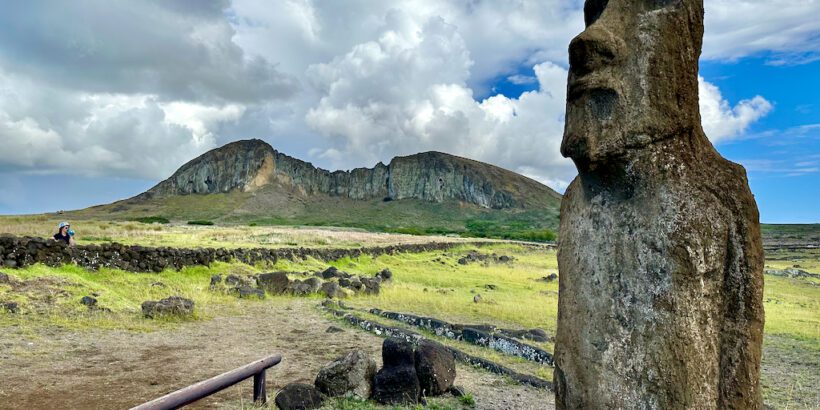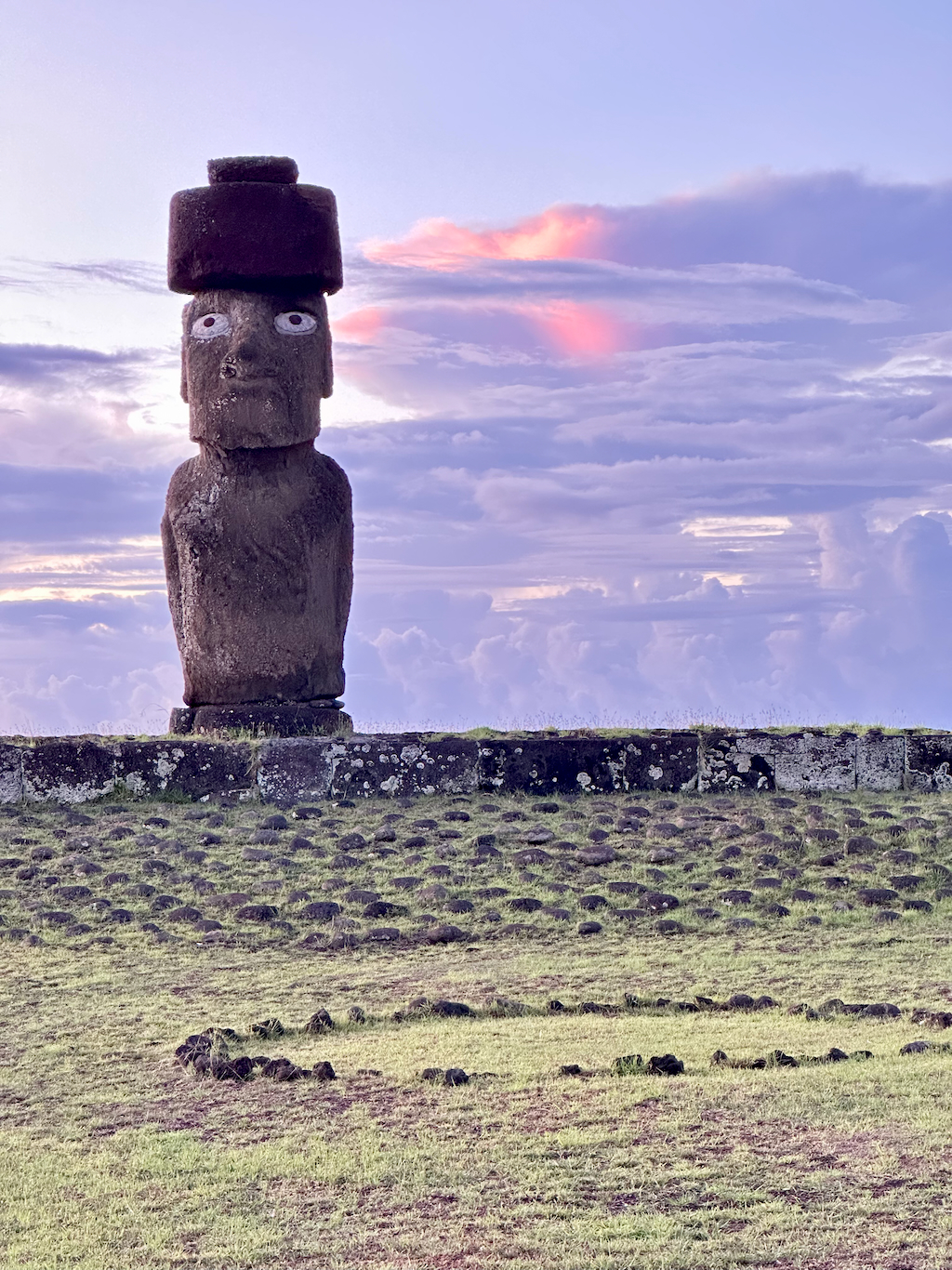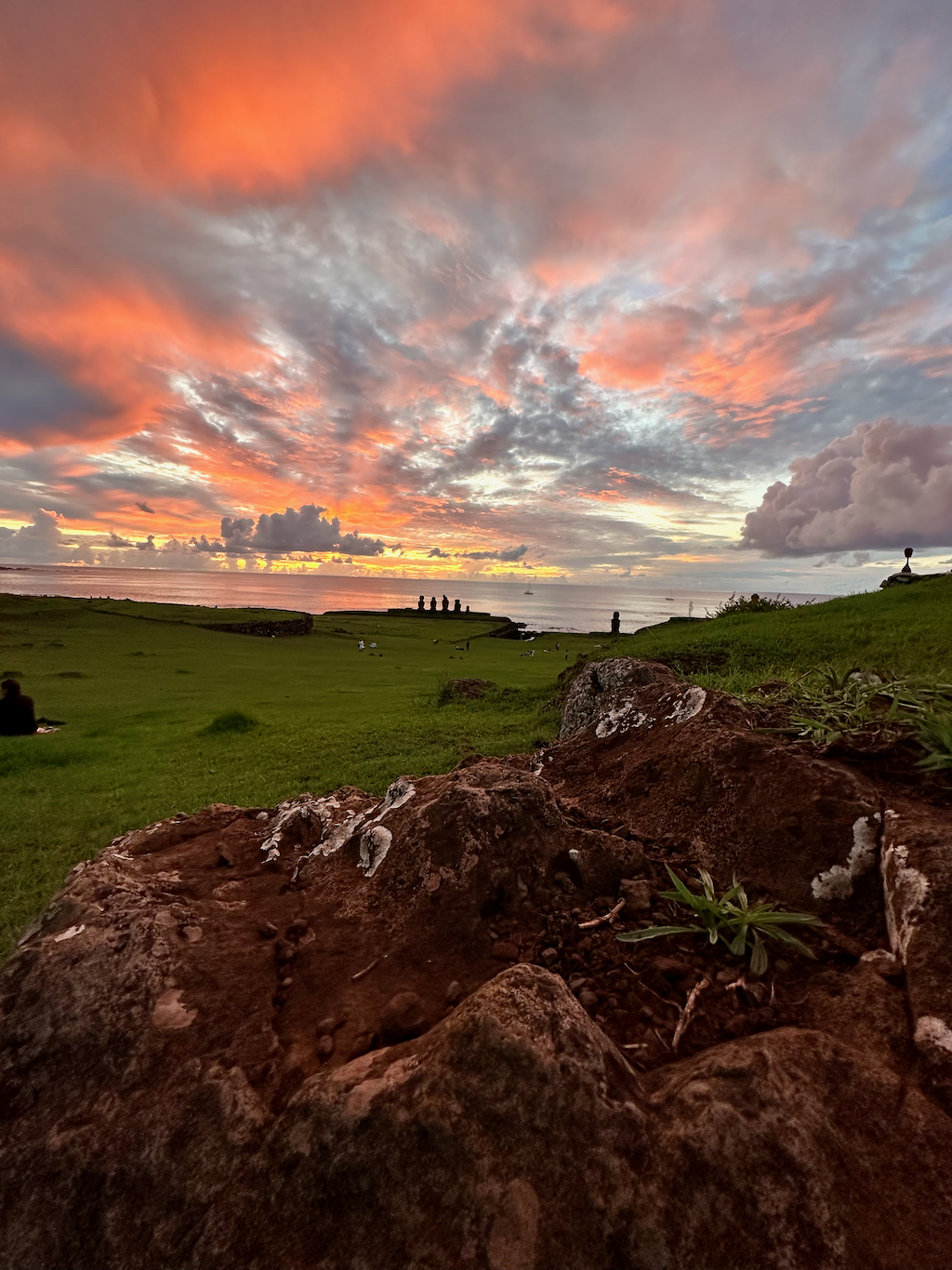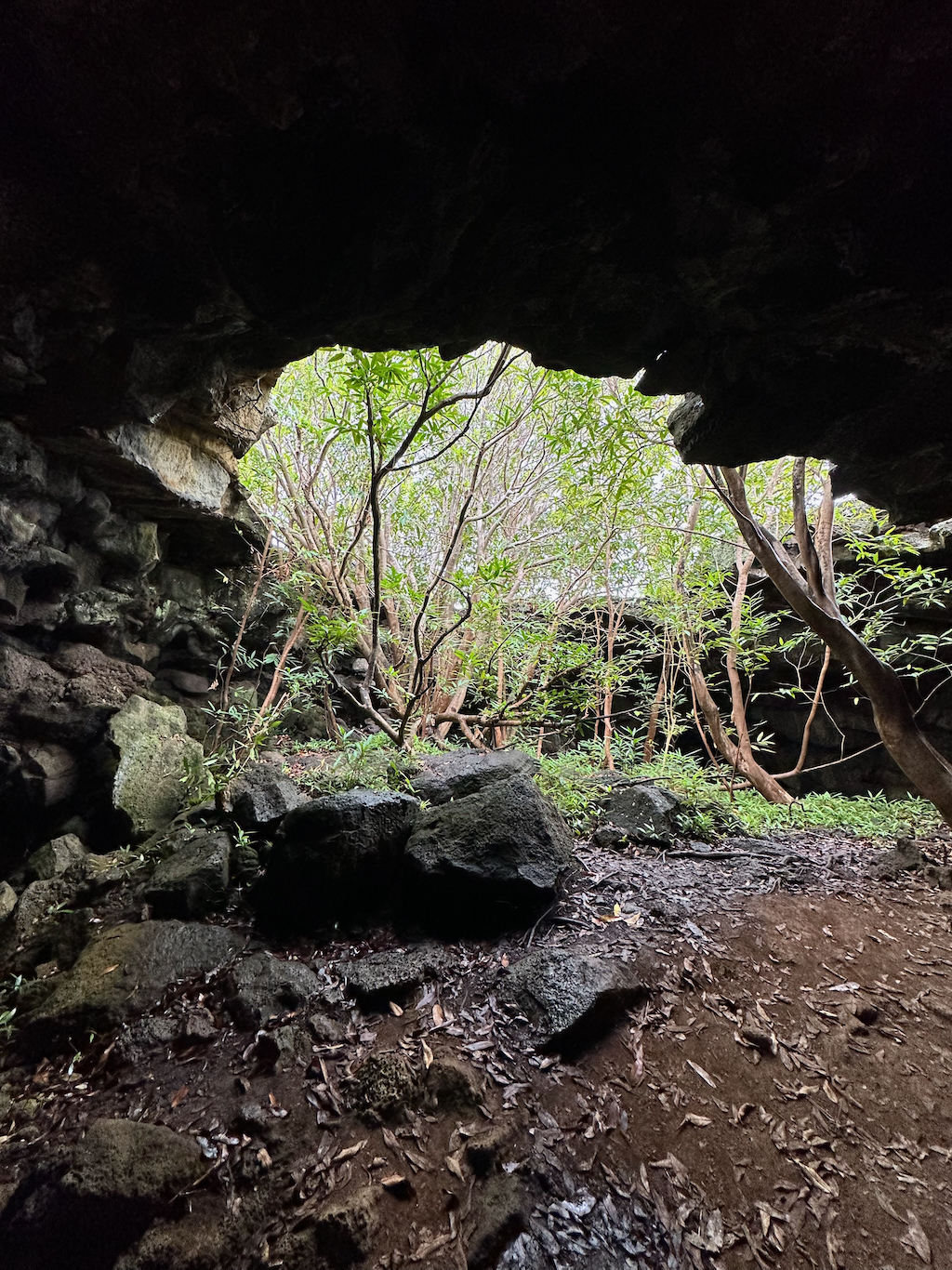Despite Easter Island being so small, there are a lot of places worth exploring here.
With so many different moai, ahus, and caves, you can easily get overwhelmed with options and lost in the rich history and fascinating stories.
So below, I have highlighted some of the best places to see on Easter Island.
I’ve also provided some historical insight into some of these spots so that you’ll better understand the significance of these sites before you visit. Trust me, it really pays to have some insight when visiting a place like this!
Table of Contents
Overview of the Best Places to See on Easter Island
Below you will find over 30 places to see on Easter Island (or in some cases like scuba diving just “things to do”). I believe these are the most “worth it” sites to see and furthermore that these will give you a very well-rounded set of experiences.
We experienced virtually all of these places and things and some of them are places we found that were not even listed on any maps or recommended by local tour guides!
To visit some of the places below, you will need a guide and not all of these places are open 24 hours.
This means that you want to do some planning and put together an itinerary that works within the amount of time you have to visit Easter Island.
Easter Island related content
You may already be aware but Easter Island is not the easiest place on the planet to visit for a few reasons.
Here are some additional articles you may find helpful when preparing for your visit:
- Guide for getting through Santiago de Chile Airport (SCL) to Rapa Nui/Easter Island
- Complete Guide to Exploring Easter Island’s Rapa Nui National Park
- How to get to Easter Island: Everything You Need to Know
- 21 Things You Need to Know About Easter Island Before Visiting
- Can You Take Rocks From Hawaii? Or Better Yet Should You?
With all of that out-of-the-way, let’s jump into the different places you’ll want to visit!
Rano Raraku
When the average persons thinks of Easter Island, chances are they are conjuring up images of Rano Raraku.
This is the birthplace of virtually all of the moai. It was here at this quarry known as Rano Raraku where the vast majority of the moai were carved out of tuff (volcanic ash) and then began their downhill journey, usually to an area along the coast.
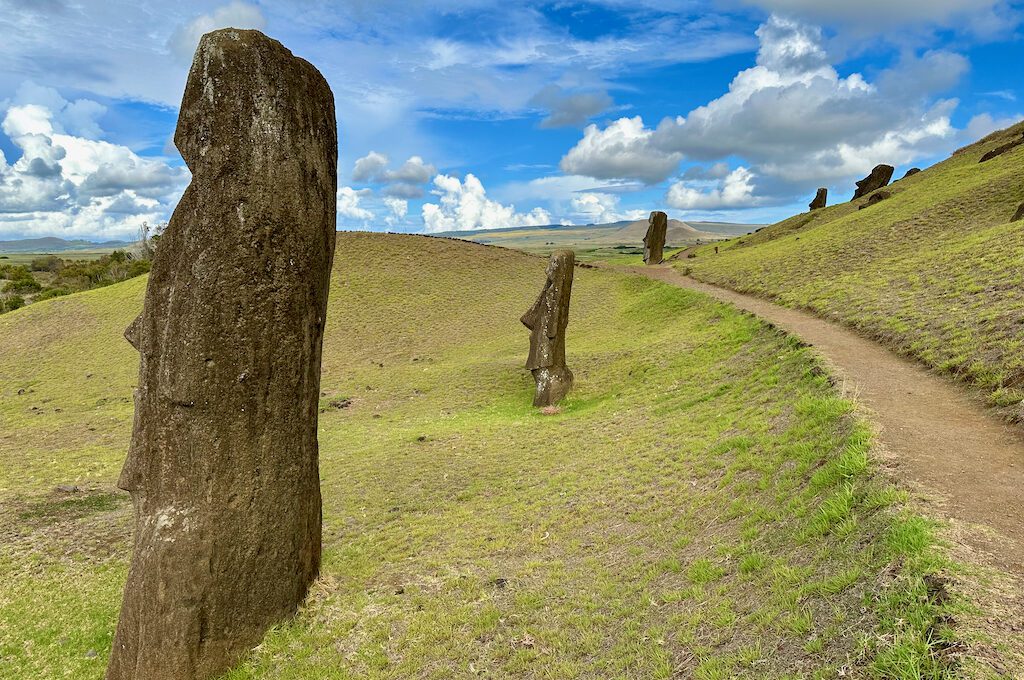
The smooth hillsides of this volcanic crater are covered with moai of various sizes and there is just something majestic about strolling through this area — I only spent 45 minutes here but I could’ve easily hung around for a couple of hours.
It’s estimated that there are about 400 statues located around Rano Raraku, so this place has by the far the highest concentration of moai.
To fully explore Rano Raraku it’s somewhat of a miniature hike so be prepared for some steps but nothing too strenuous.
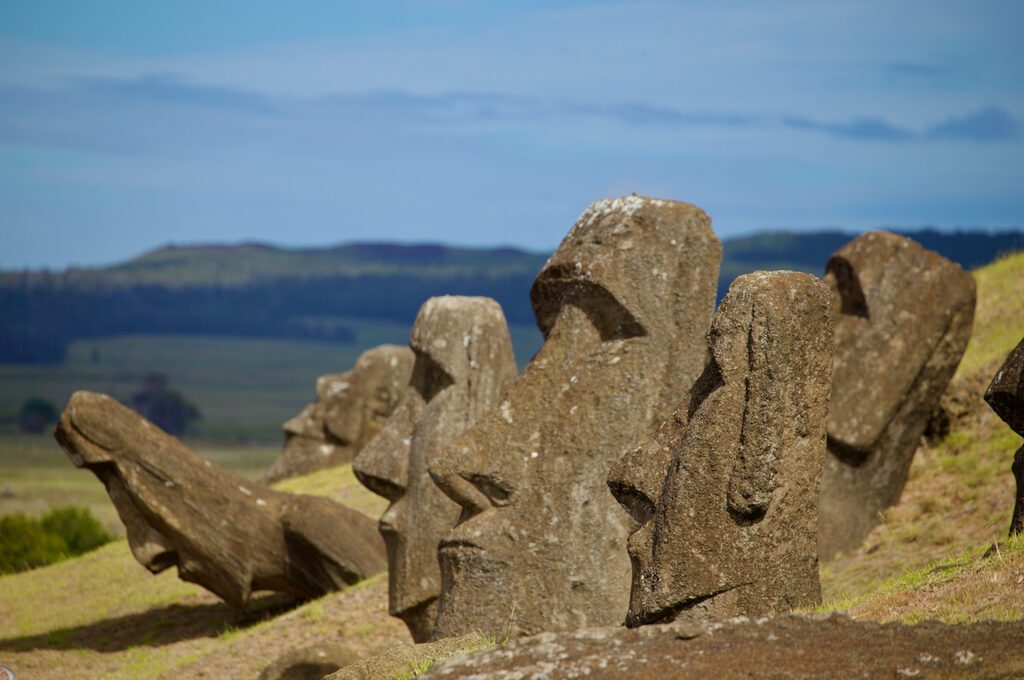
I particularly liked seeing some of the huge moai still unfinished, including the largest one which would have stood an unimaginable 60 to 70 feet tall! You really get the feeling of history being frozen in time at this place like no other.
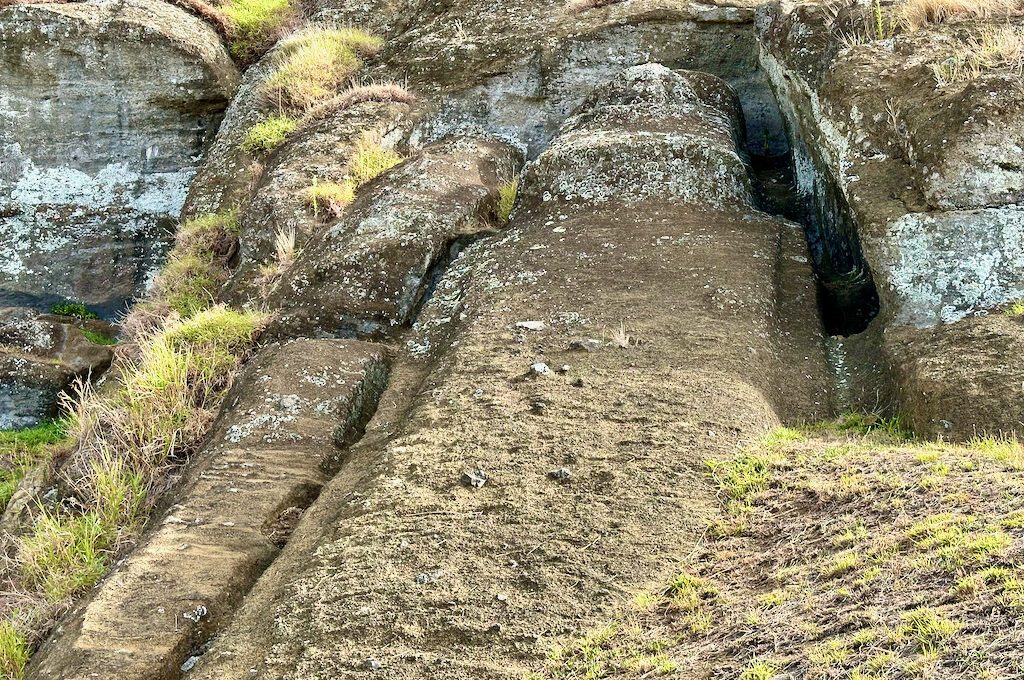
Something extra fascinating about Rano Raraku is that there is a lake on top of it that recently went dry. In fact, that is where a moai was discovered while we were visiting the island!
This is one of the destinations that you only can visit one time per park entry pass so make sure that you give yourself plenty of time and that you visit when you have all your energy.
If you only have a short amount of time on Easter Island then you have got to see Rano Raraku — there’s simply is no way around it!
Ahu Tongariki
Ahu Tongariki, which can be viewed from the hill sides of nearby Rano Raraku, is one of the most popular sites on Easter Island.
The largest ahu on the island, you’ll find a row of 15 stone giants towering along the horizon including the largest one erected on the island which weighs a whopping 86 tons! Like some other ahus, this one is oriented to the sunrise on the summer solstice.
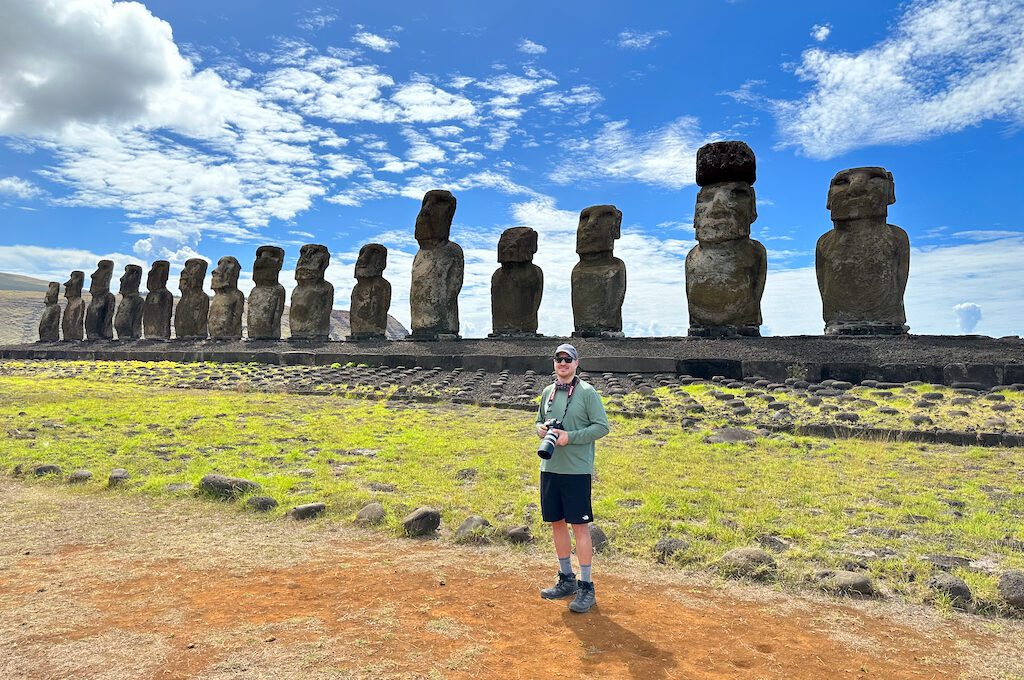
Not only can you appreciate Ahu Tongariki from the front but take a loop path around the back which gives you an entirely different perspective.
Ahu Tongariki required decades of restoration work after a powerful tsunami in the 1960s caused a great deal of damage to the ahu. What you’re seeing today is a relatively recent product!
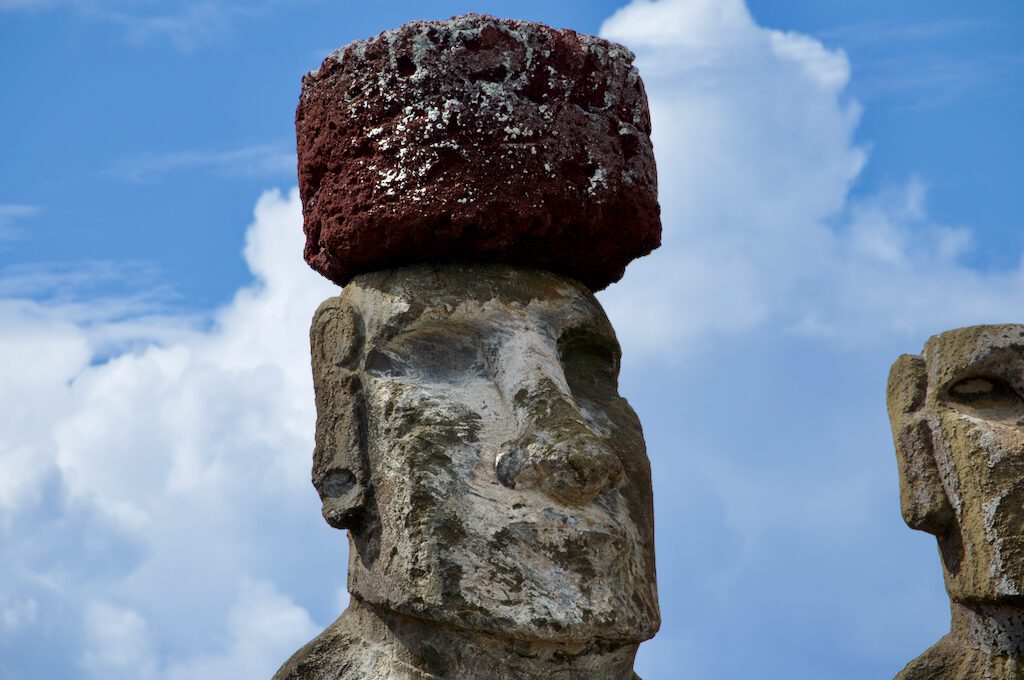
Ahu Tongariki is THE spot where people convene for the sunrise.
There’s a small mound in front of the ahu and if you get there early enough you can lock down that spot. But there is plenty of space to get a great view of the sunrise here.
Before the sun emerges, look for a bright “star” that is probably actually the planet mercury as seen in the photo below.
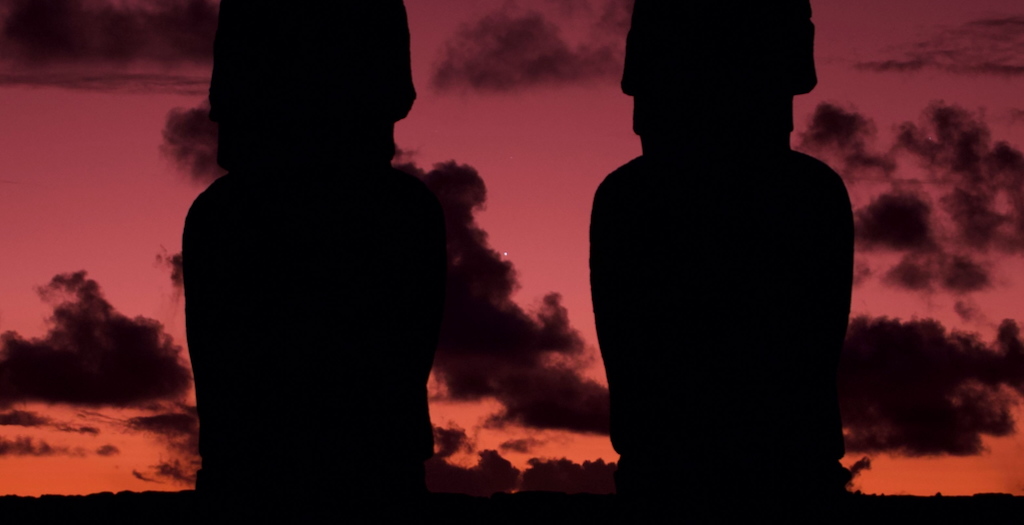
I would recommend that you get here 30 minutes to an hour before astronomical twilight ends so that you can stargaze under some of the darkest skies you’ve ever seen: Bortle 1 skies!
We were fortunate enough to watch the Milky Way rise behind these beautiful moai statues and it was a sight I’ll surely never forget.
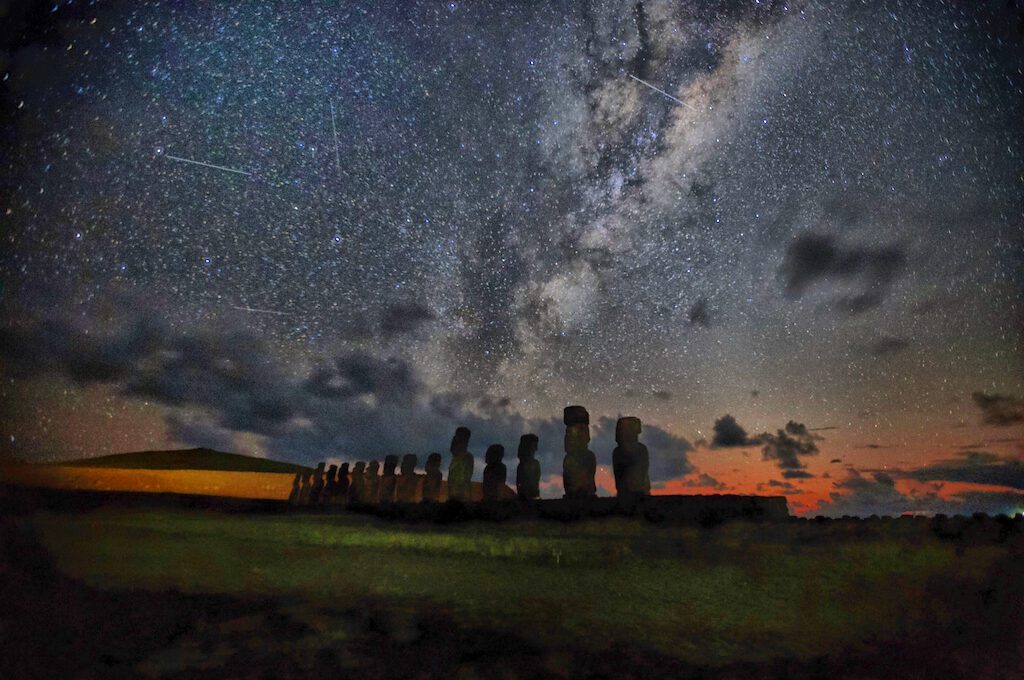
If you are interested in stargazing there is a stargazing tour where you can actually use a telescope to admire the night sky. Unfortunately, availability did not line up for us so we just did our own stargazing which was still very impressive to see.
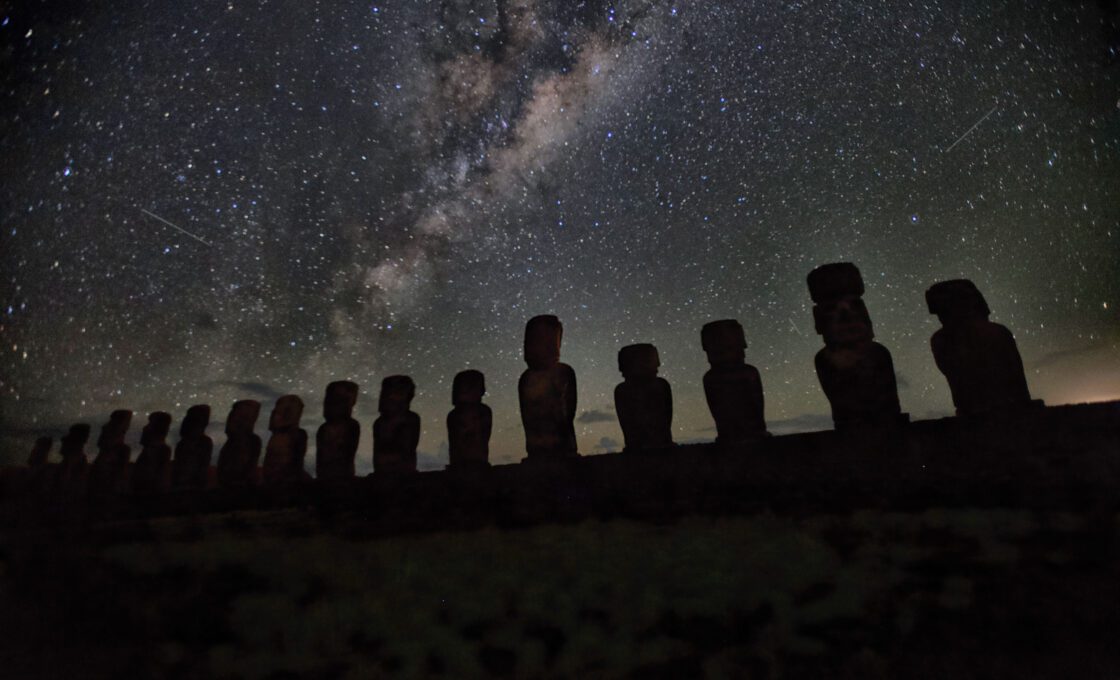
Easter Island is in the Southern Hemisphere so for people coming from the Northern Hemisphere (US, Europe, etc.), you can observe a much different night sky.
If you don’t know much about stargazing, here’s what to look for:
- Southern half of Milky Way Galaxy
- Carina Nebula
- Southern Cross
- Magellanic Clouds (two cloud-like things pictured below)
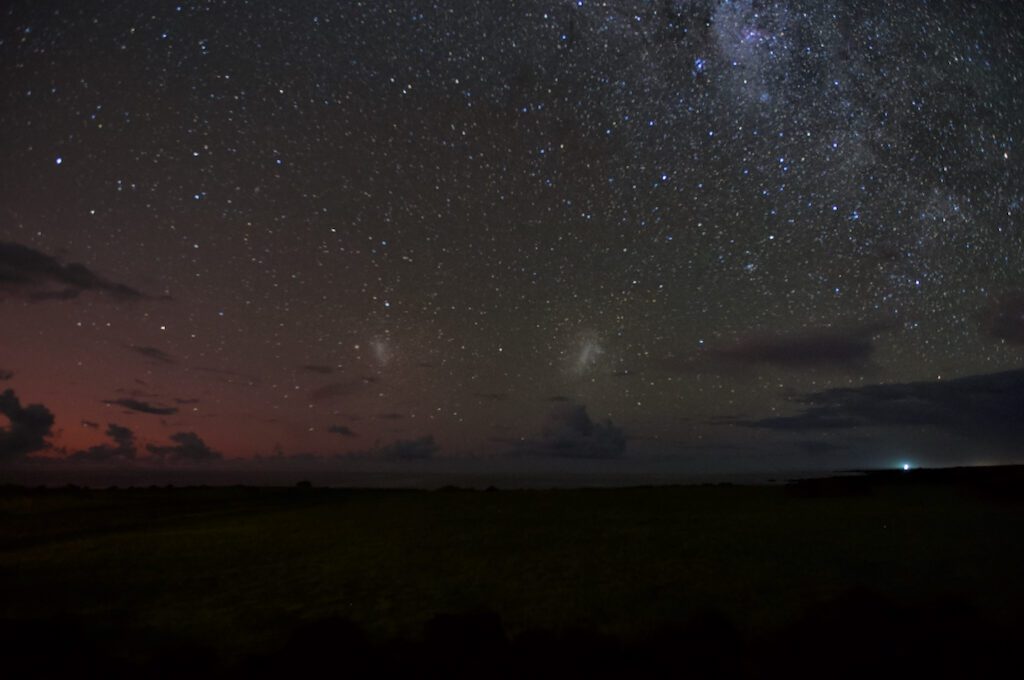
Ahu Tahai
There are quite a few places worth catching the sunset on Easter Island and Ahu Tahai is probably the most popular.
We checked out the site on a couple of different evenings and one of those nights blessed us with a sensational sunset. You likely will run into some crowds here but every night that we visited, the crowds were never that bad.
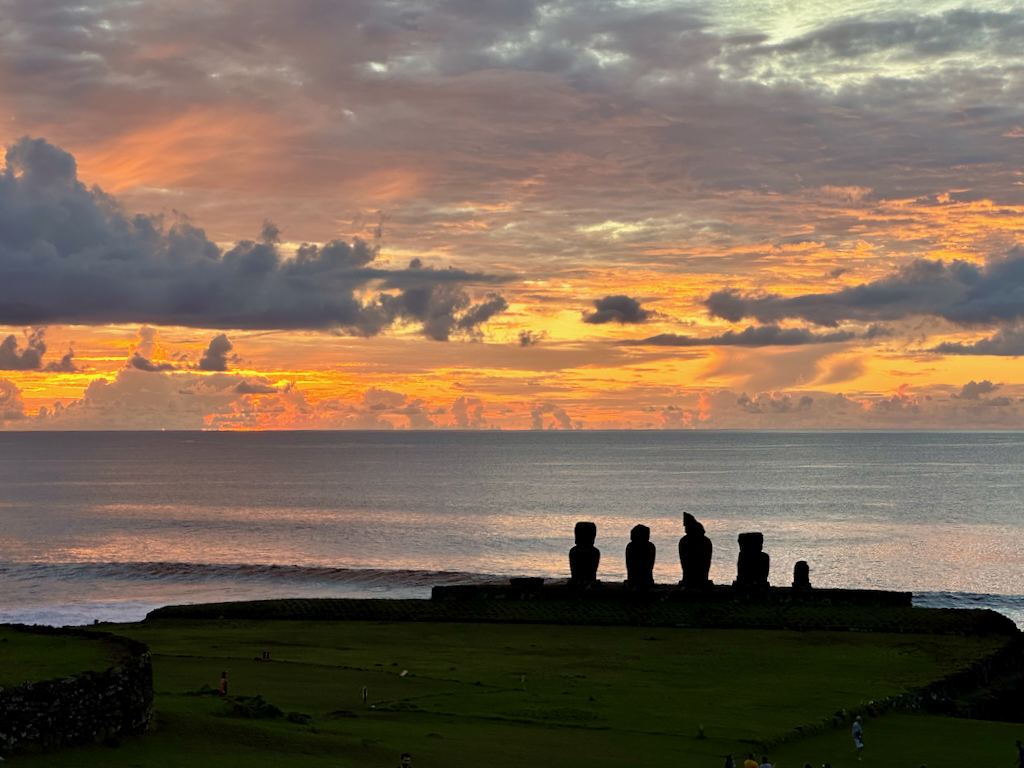
This is also one of the few places where you will see a standing moai with restored eyes. These were typically one of the last things added to a moai after it arrived at its ahu.
There’s something about those white eyes that make the moai take on a completely different appearance, especially with a magnificent sunset in the background!
The other great thing about Ahu Tahai is that you don’t need to have a guide with you and it is open all night so it’s also a great place for stargazing (although there is some nearby light pollution).
Mirador Hanga Kioe
If you want a more low-key sunset spot then head to Mirador Hanga Kioe.
It’s just a little bit up the road from Ahu Tahai and it’s another spot that does not require a guide. I like this spot because it primarily features a single moai and it’s also very easy to access.
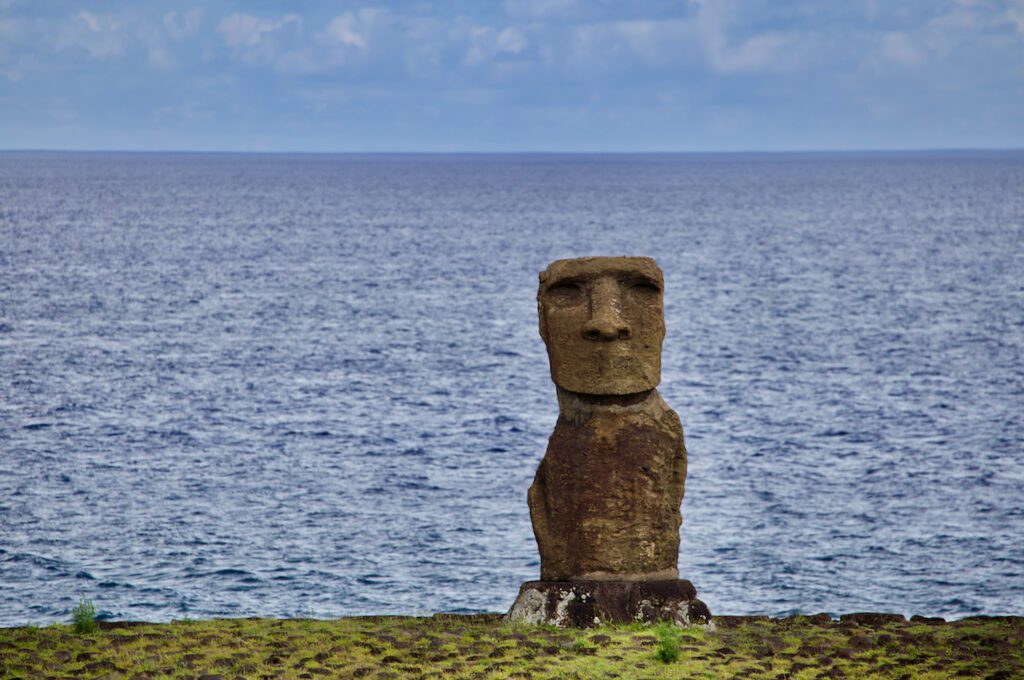
We watched the sunset here the first night of our trip and there were only a couple of other people in this wide-open area. It was a very still and spiritual type of feeling compared to the more festive oriented Ahu Tahai.
The light pollution over here is also less of an issue so this could be a better place for stargazing or astrophotography.
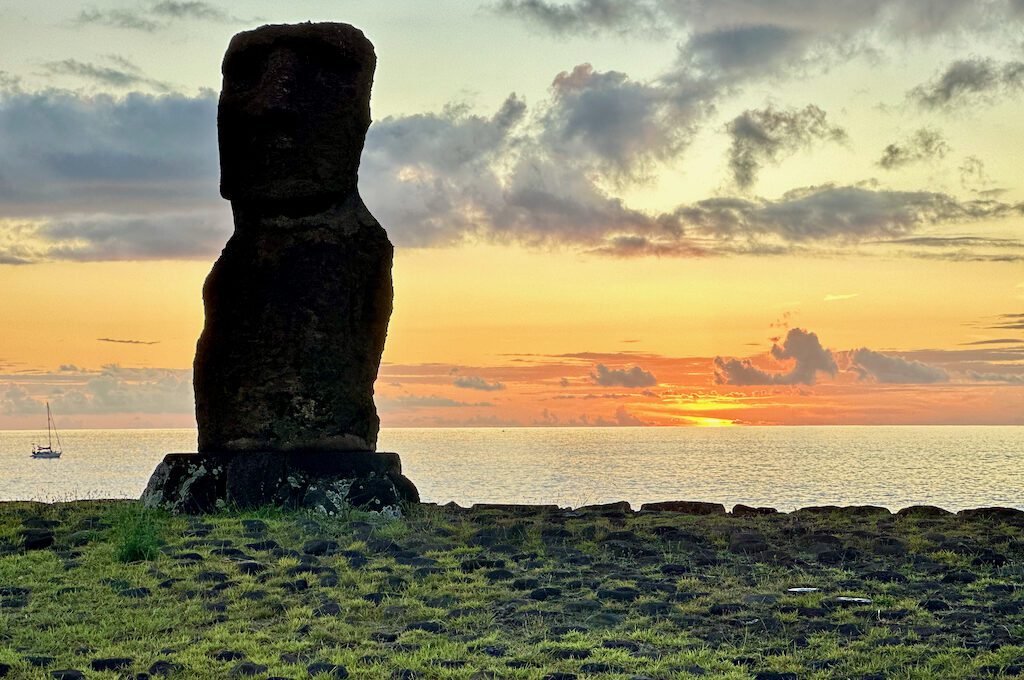
The blowhole
Just a little up the way from Mirador Hanga Kioe is a cool little blowhole that you can get up close to.
We randomly stumbled upon this so you probably won’t find this on a map or local guide books. It’s found right about -27.128737090229826, -109.424727846241. It seemed to be firing away around low tide but I’m not sure if it also puts on a performance around high tide. Perhaps it’s even more impressive then!
This is also just a cool spot to go tide pooling and to admire the rocky coastline. We found lots of sea urchins, crabs, and some really cool coral fragments. (Of course, you can’t take these with you.)
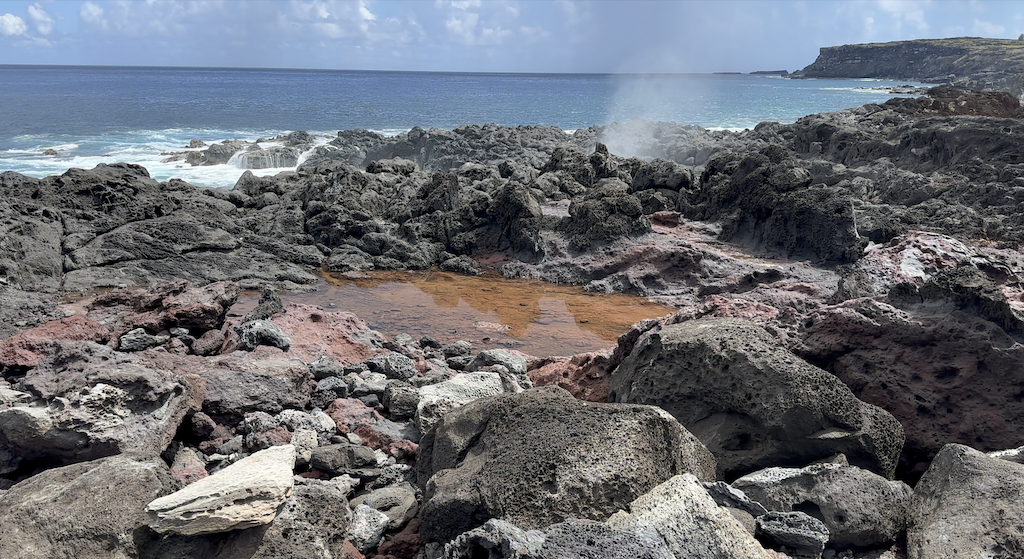
Go to a dance show
Another thing that I would consider a must to do is to attend an evening dance show. Music and dancing is big here and the shows are a sight to behold.
Personally, I enjoy luaus in Hawaii but these Polynesian shows are a little bit different.
They are smaller and more intimate than your typical luau, so it’s easier to get up close and personal with the performers which I really liked. The shows also had more of a “primitive” feel to them with less reliance on the spectacles.
The show that we saw was Te Ra’ai, which might be the most popular.
They offer a full package or you can participate in a traditional dinner. We opted just for the show. Make sure you don’t turn down your opportunity for some face painting and a traditional head dress!
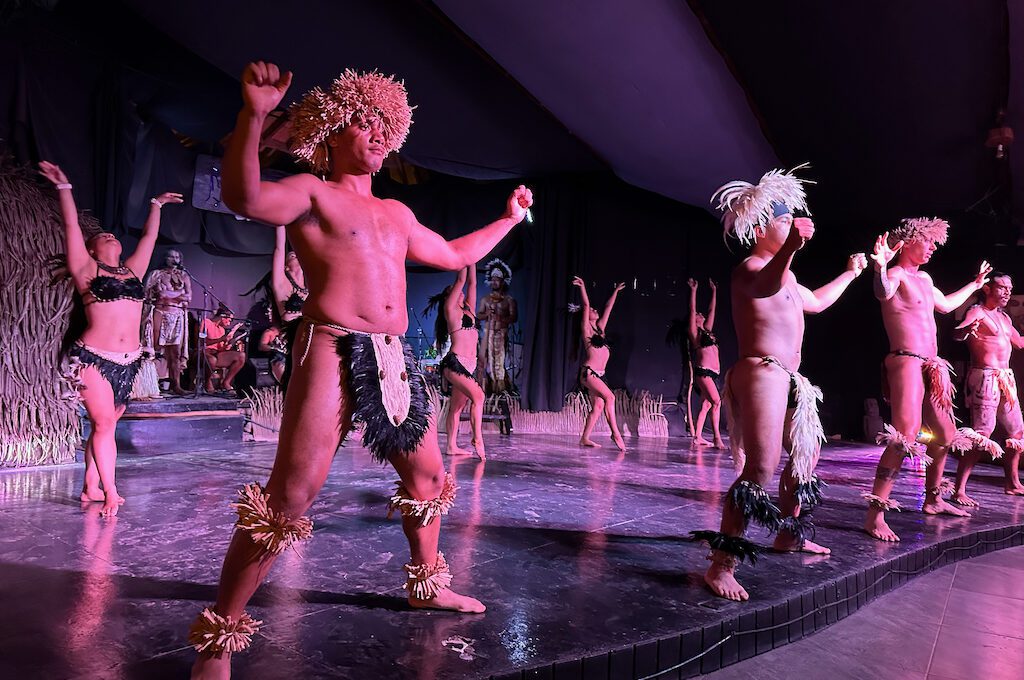
Other shows to look at to attending include Kari-Kari, Te Moana, and Vai Te Mihi. We actually were able to enjoy a surprise outdoor show by Kari-Kari at our hotel which I really enjoyed. They literally stopped traffic which was pretty funny!
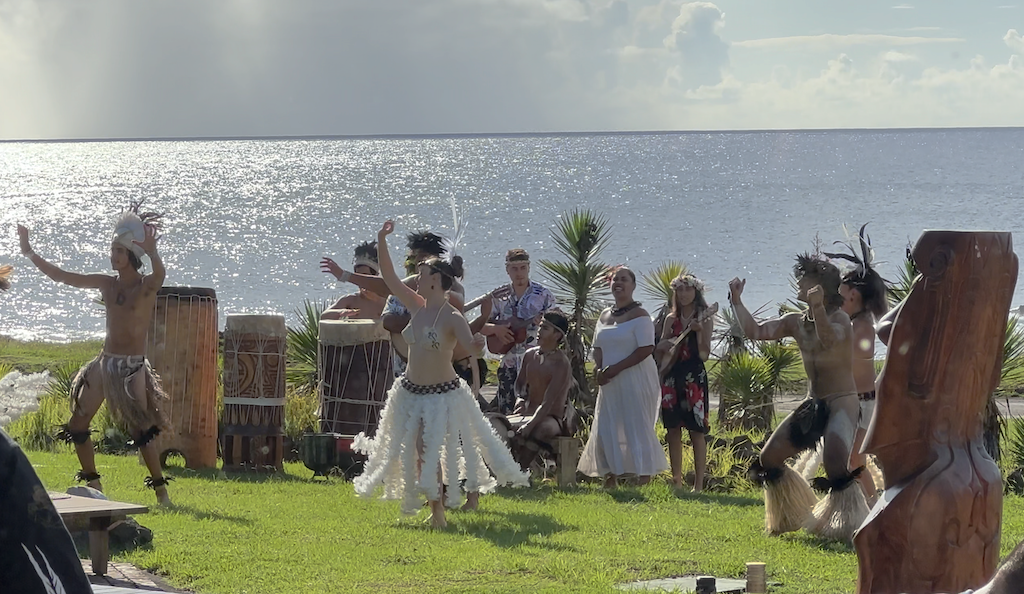
You can talk to your tour guides and locals about which show is best but chances are you’ll end up getting recommendations for all of them!
Note: Sometimes they may not have enough audience members to put on the show for the night so you may have to get confirmation just before the show starts in some cases.
Orongo
Orongo is a ceremonial village found on the rim of the Rano Kau volcano and is one of the most significant sites on Easter Island.
A UNESCO World Heritage Site, it served as the hub for the Tangata Manu or “Birdman” cult. After the moai culture declined sometime in the 16th century, the “Birdman” ceremonies took place here.
Clan members climbed down the treacherous cliff side and made a swim to the islet of Motu Nui, where they would attempt to recover the first sooty tern egg of the season. Then they’d swim back and climb back up the cliff.
The first person to return with an intact egg was declared the Tangata Manu or “Birdman” and earned the right to rule the island for the following year.
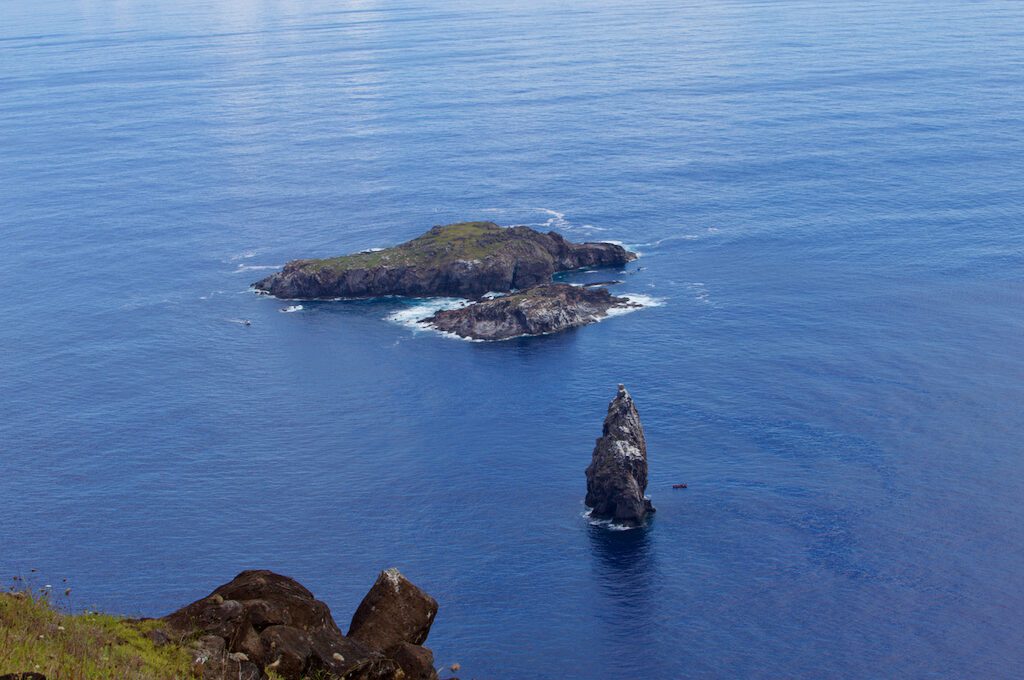
As you wander atop the cliff sides, you’ll get up close views of the stone houses (hare paenga). These were used by the competitors during the ceremony, which I was told lasted up to a month.
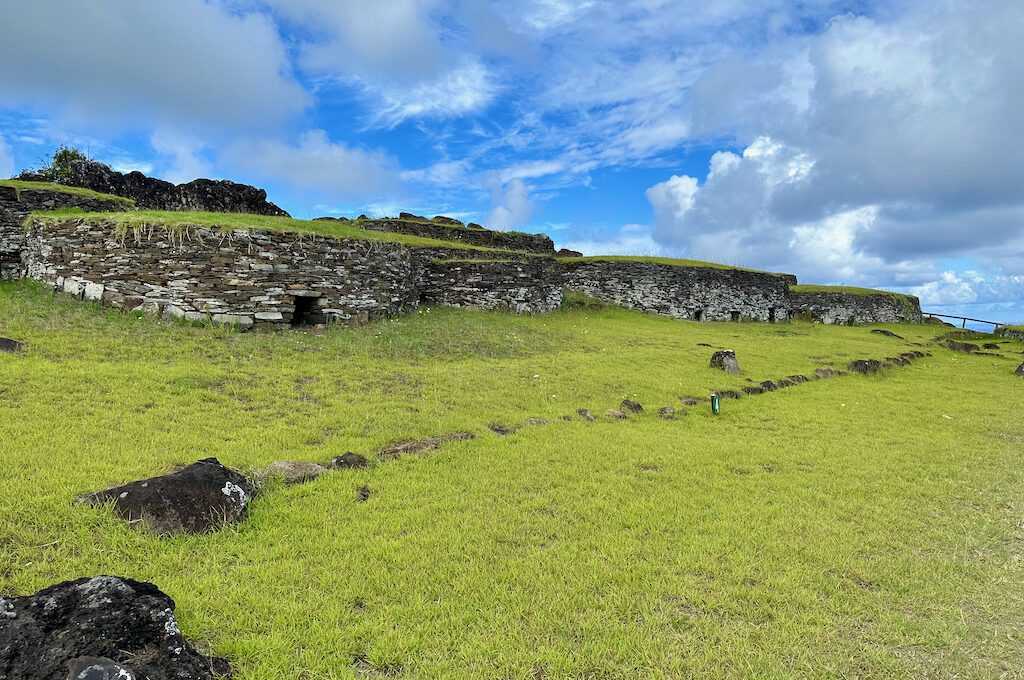
Your tour guide should also help point out some of the petroglyphs or rock carvings depicting the Tangata Manu and then eventually show you an amazing view of the crater.
Note: You can only visit Orongo one time per park pass.
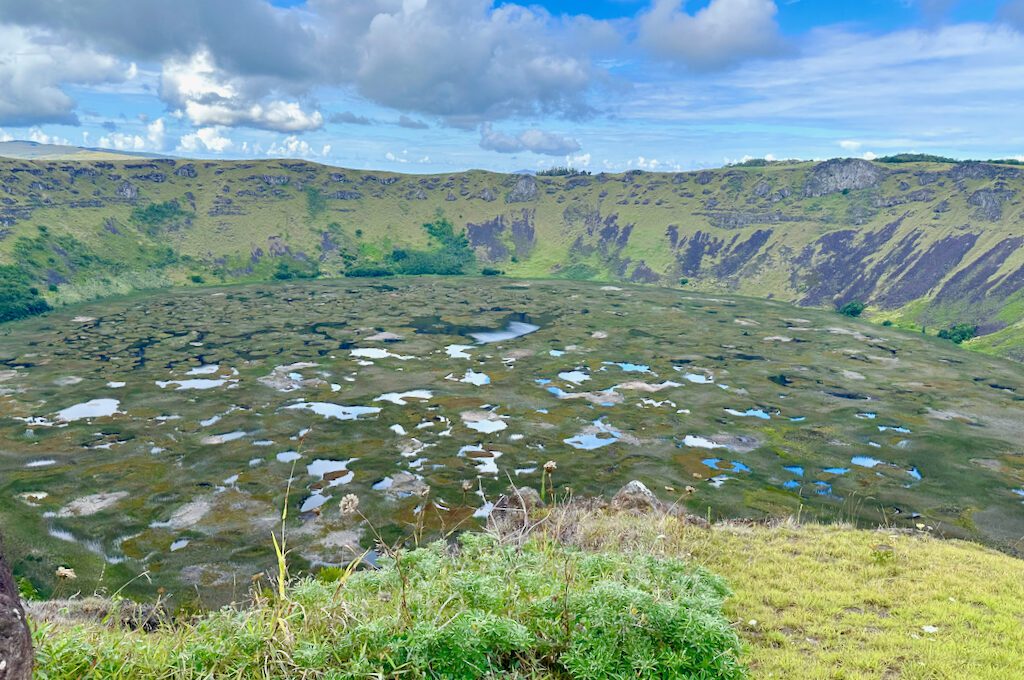
Mirador Rano Kau
Mirador Rano Kau is the lookout point for the Rano Kau crater that has the added bonus of a beautiful ocean view in the background.
You definitely want to stop by after a visit to Orongo but the great thing about the spot is that unlike Orongo, you don’t need a guide.
This is also where the trail drops down into the crater so if you are feeling adventurous you can give that trail a shot.
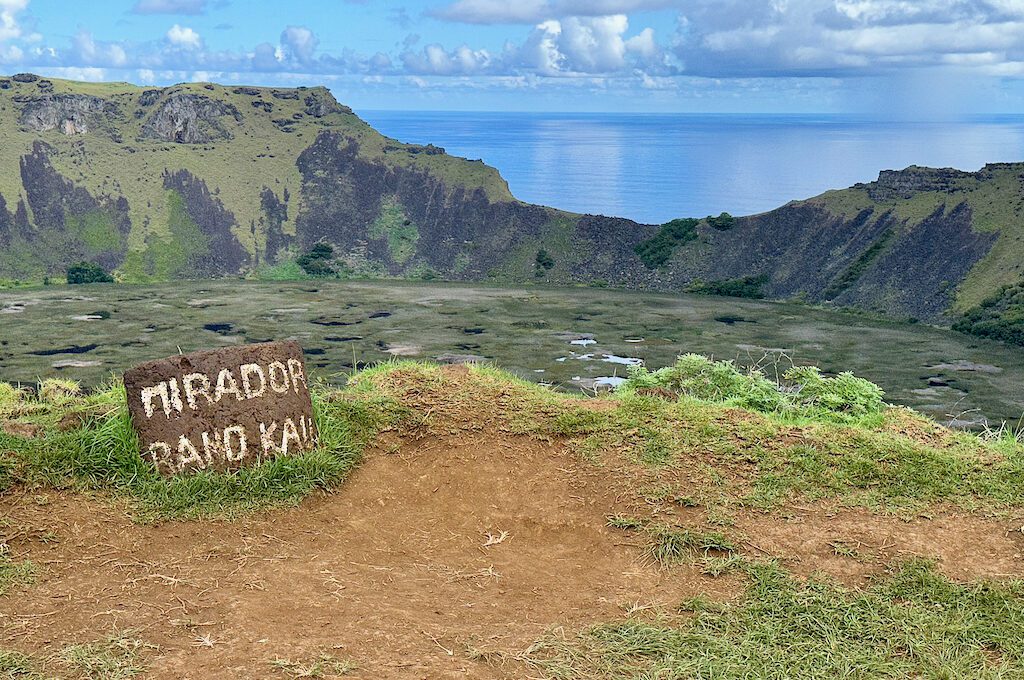
Ana Kakenga
Ana Kakenga was one of the major highlights of the trip for me. It’s probably the most iconic lava tube on Easter Island. If you just want to see this cave, it’s about a 2.25 mile round-trip hike with just a small amount of elevation gain.
Hopefully, your guide will take you along the coast so that you can admire the impressive cliff views but be careful about getting too close. Also, make sure you don’t roll your ankles on the uneven terrain.
There is no official trail along the coast — you just sort of find your own route. But on your way back, you can walk along the road which is a much easier path with less risk for rolling an ankle.
During the winter months you might be able to spot whales off the coast but if the whales are not there, you’ll probably see some people practicing for canoeing competitions.
There were some seriously skilled canoers slicing through the swells during our visit!
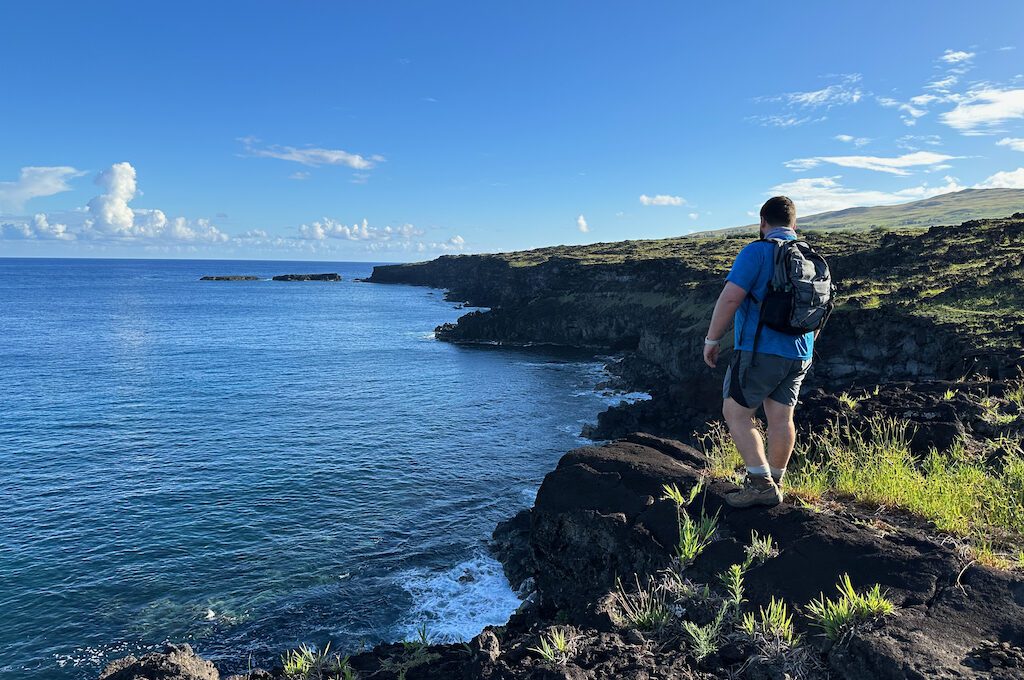
As for the cave itself, it has a pretty small opening that you enter through.
I’m personally pretty claustrophobic but I was able to power through the cave because it is only confined for a short amount of time. Then it opens up to two separate windows that look out to the ocean.
Taking in the views from those lovely two windows was extraordinary.
I don’t know of many other places where you can do this so.
To make life easy for yourself wear a headlamp, especially if you want to do any kind of recording while you are going into the cave. You can also leave your backpack at the entrance of the cave to make it easier to get through the tight spots.
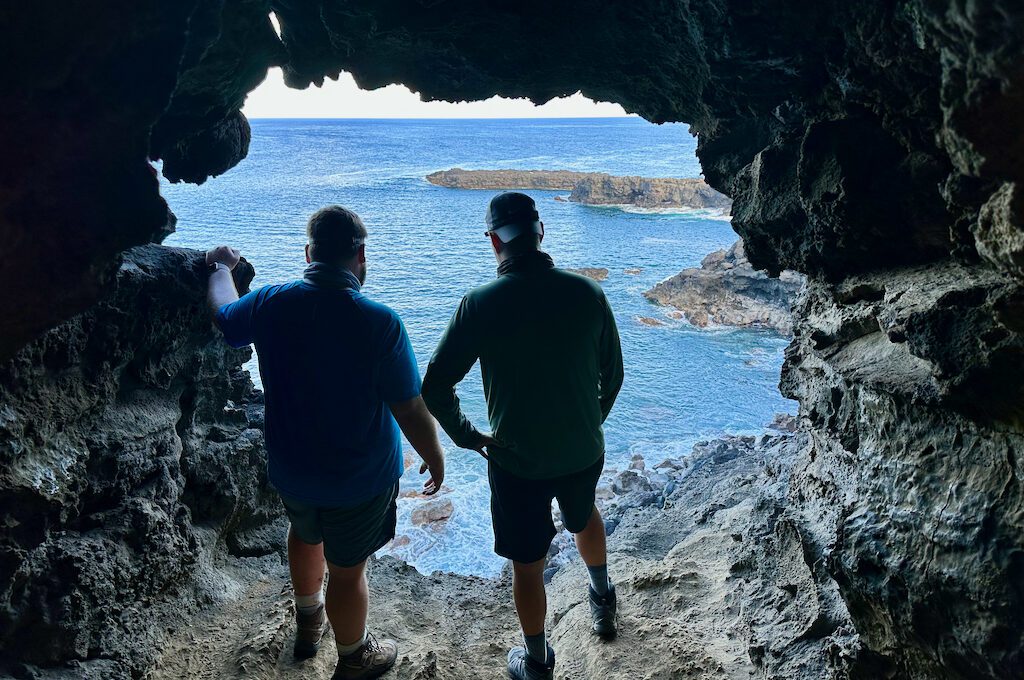
Ana Te Pahu
Another very famous cave is Ana Te Pahu. We did not visit Ana Te Pahu proper but instead went into a “secret” cave that I believe is next to it or at least is very close to it.
The opening to the cave was wide and had a pretty large tree coming out of it which we had to use to help us climb down a pretty steep little path.
Once inside, this cave had a pretty confining crawl that we had to do to get to this little under water pond which was pretty interesting to see.
In retrospect, I wish our guide would have offered us to also see the main cave known as Ana Te Pahu, because it would’ve been cool to see both of them.
You can talk to your guide about seeing all of the caves in one trip which would also include Ana Te Pora and Ahu Tepeu — just make sure you have the time for them.
Anakena Beach
You won’t find many beaches on Easter island but the premier beach without a doubt is Anakena. It’s home to a pretty wide beach area (for small island standards) and it’s quite a beautiful beach.
It’s also the place where the original settlers came to shore according to legend.
Some people consider Easter Island to be the “final place” that mankind settled after spreading out from Africa, through Asia, and throughout Polynesia. So in a sense, it could be argued that this beach is where the first major wave of human exploration reached its furthest point.
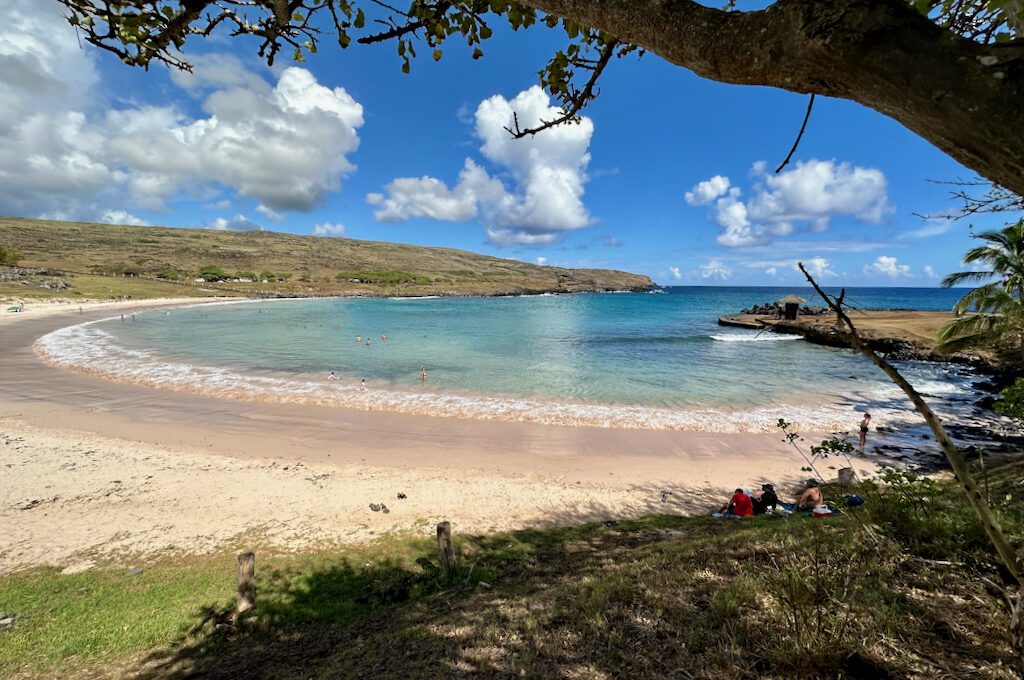
There’s a small trail that takes you to the end of the beach where you can admire the views or even check out a shaded area where campers can take advantage of one of the most idyllic campsites.
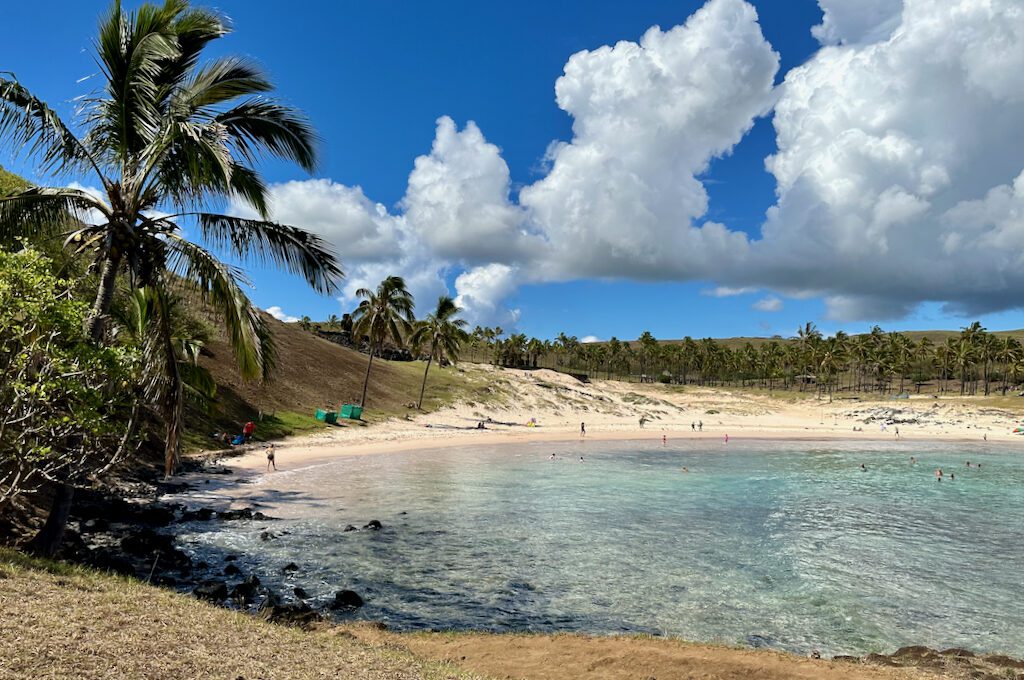
If you visit in the afternoon, you’ll find a few different restaurants (all next to each other) serving up scrumptious ceviche and hearty fried potato dishes. Just make sure you have plenty of time because each time we ate at these restaurants, it took about 45 minutes to an hour to get our food even when the crowds were nonexistent.
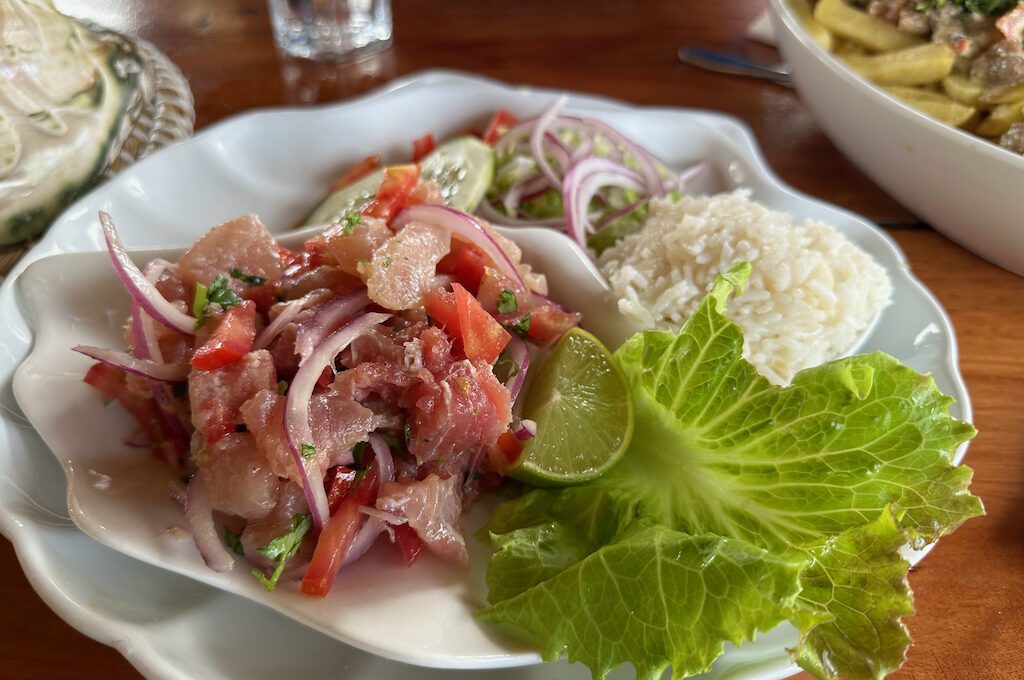
A few other things to know about the beach:
- Beautiful palm trees provide shade where you can rest and relax on picnic tables.
- When the cruise ship was in town, Anakena became significantly more crowded!
- They have bathrooms at the beach which makes it easy for you to spend more time here.
Ahu Nau Nau
Just next to Anakena is Ahu Nau Nau, one of the most picturesque ahus on the island with well-preserved moai.
If you like seeing moai with pukao (the red headdresses) this is the best place to catch them since most moai are not adorned with pukao.
It’s believed that construction of this ahu involved three stages spanning from 1100 AD to 1400 AD and that the site is connected to the earliest history known to the island.
Although Ahu Nau Nau is located just next to the beach, you are still required to be accompanied with a guide to visit it.
There is a hill that you’ll see in this area and if you want a higher vantage point, you can make the trek up the hill.
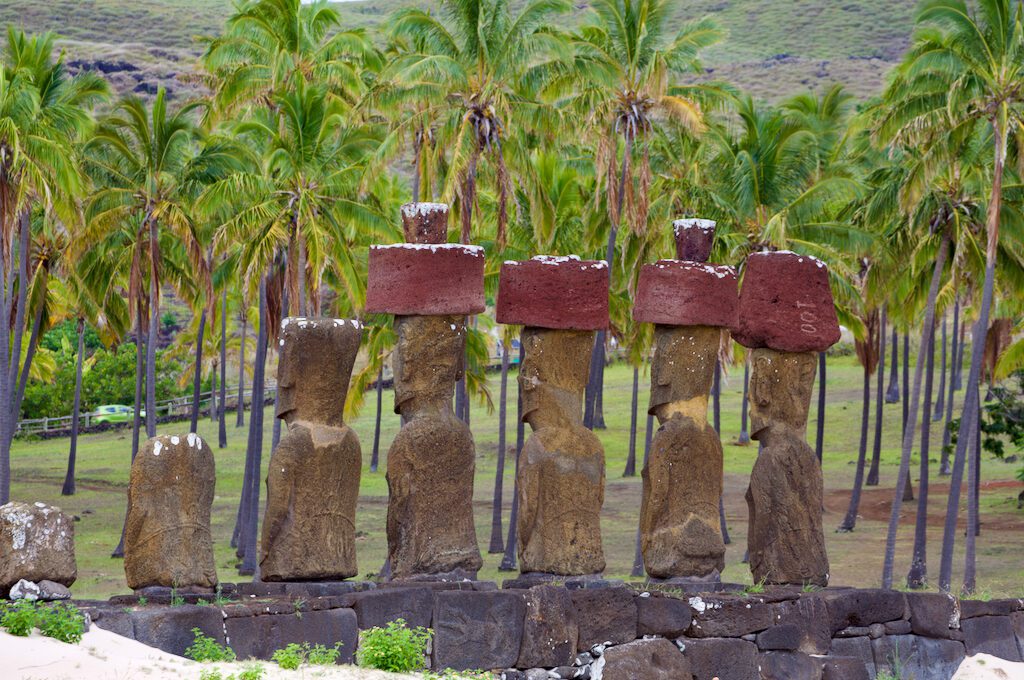
You can also check out Ahu Ature Huki, which is another moai located right next to Ahu Nau Nau. I thought this one was interesting because it had a very “stretched out” appearance.
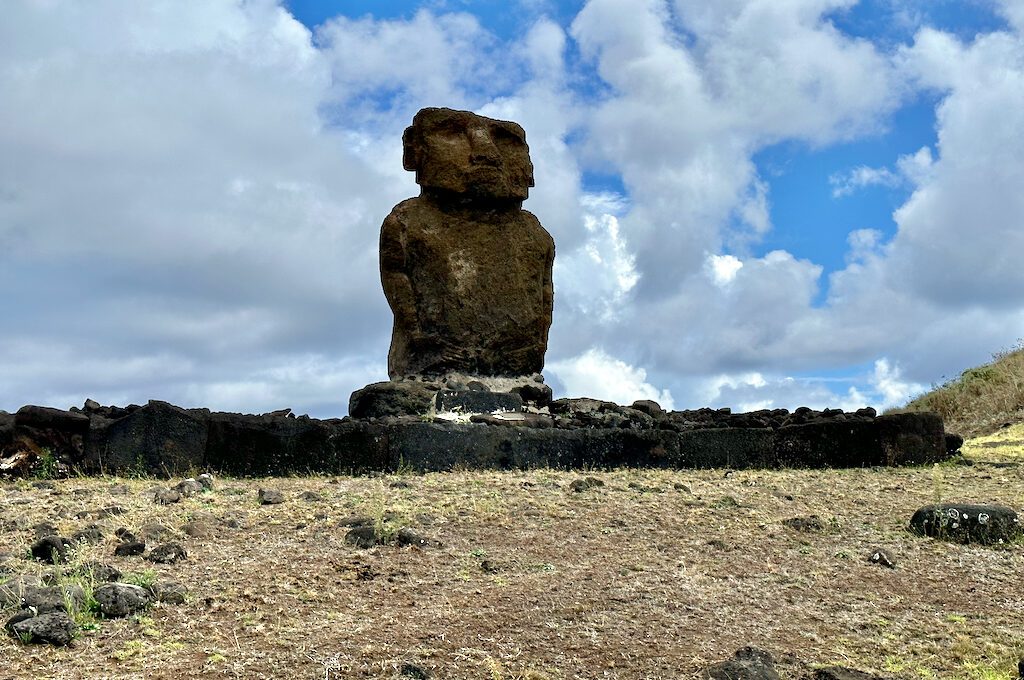
Ovahe
The other main beach to visit is Ovahe, located just a couple of minutes away from Ahu Nau Nau.
Ovahe doesn’t have all of the restaurants and tourist facilities so it also has fewer crowds. You’ll need to walk along the trail to get down to the beach area but it’s pretty easy to do.
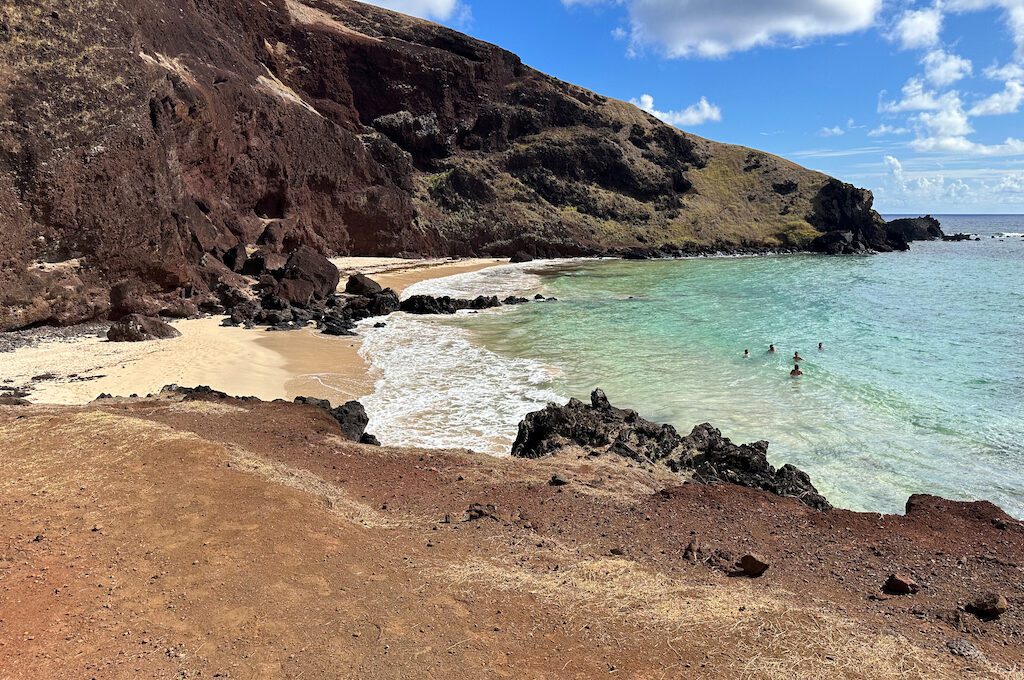
There actually are two different beaches here but you need to climb some rocks to get to the second one. You will surely be tempted by some of the caves in the cliffs but those are off-limits so be sure to respect the signs keeping you away.
The manmade bath
There’s a cool little spot located directly across from Pu o Hiro (near GPS coordinates -27.0933464396, -109.2803474044).
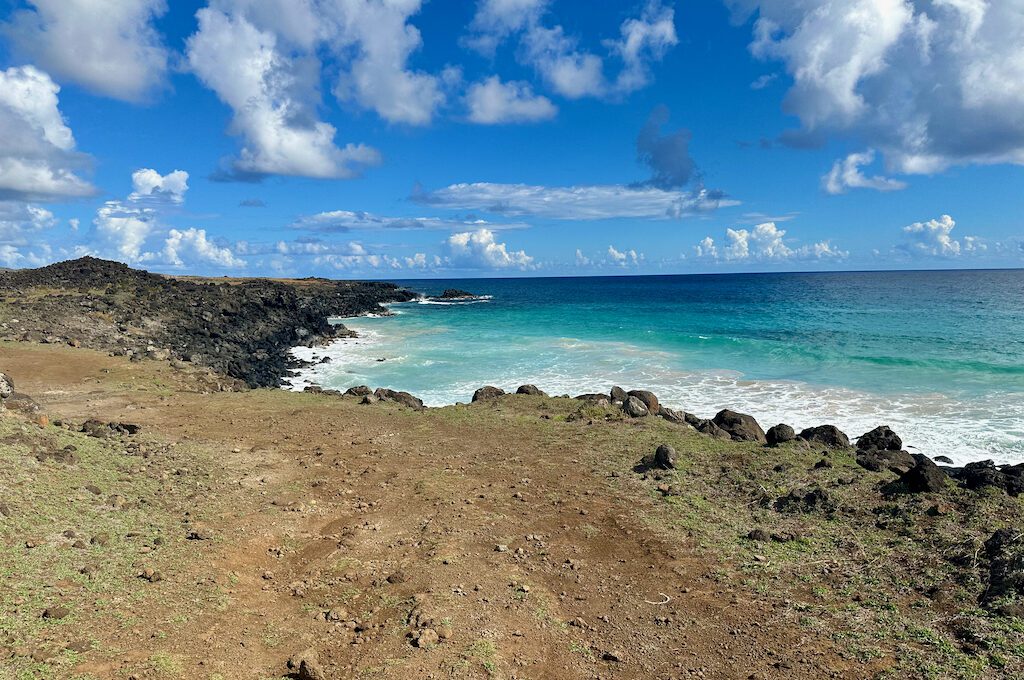
I didn’t see a name for it on any maps but it’s a cool spot with beautiful turquoise water and a little man-made bath placed right on the coast. You’ll take a short little dirt road to get to the edge of the coast and then you can simply walk down to check out the bath.
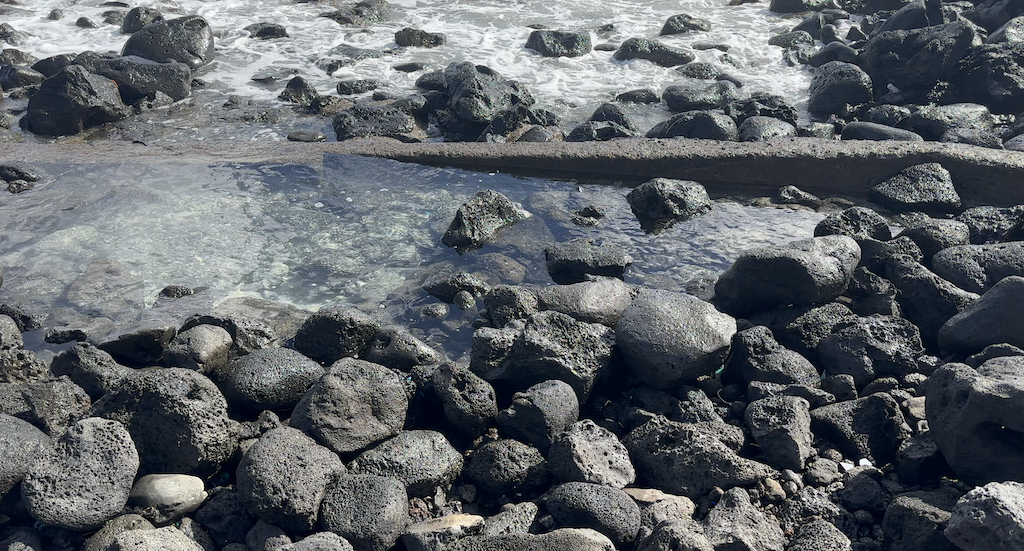
Playa poko poko
While its name may indicate a beach, this is more of a natural swimming pool sheltered from the waves.
The shallow waters makes it a fantastic spot for families and others who don’t want to venture too far from the coast. You can swim, snorkel, and just soak in the clear waters here.
Since Playa poko poko is located so close to the city, it’s one of the easiest spots to get to.
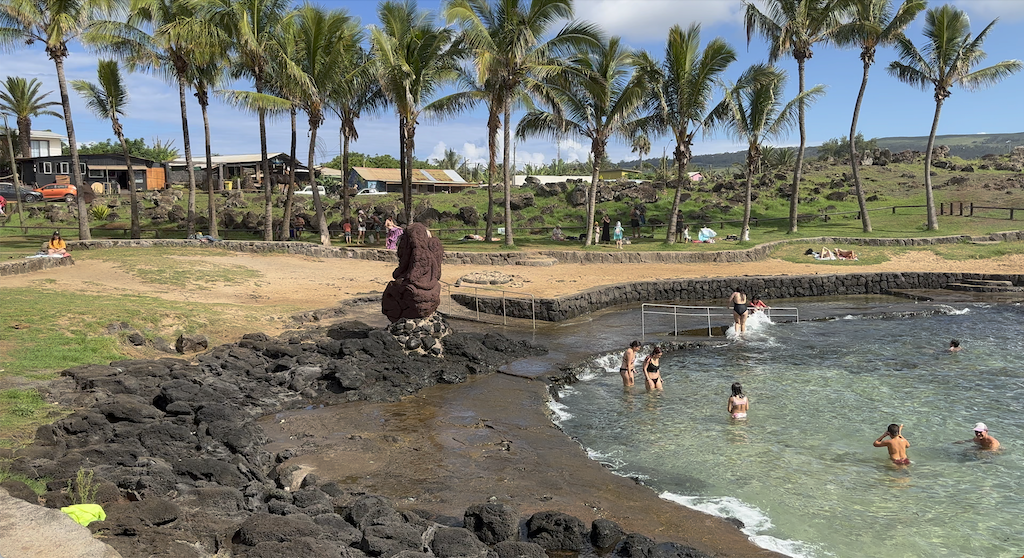
Pea swimming pool
About 1,000 feet away from Playa poko poko is the Pea swimming pool. This is another nice protected area to get into the water and go for a nice little swim.
There are two sides to this area with one being larger and more protected than the other.
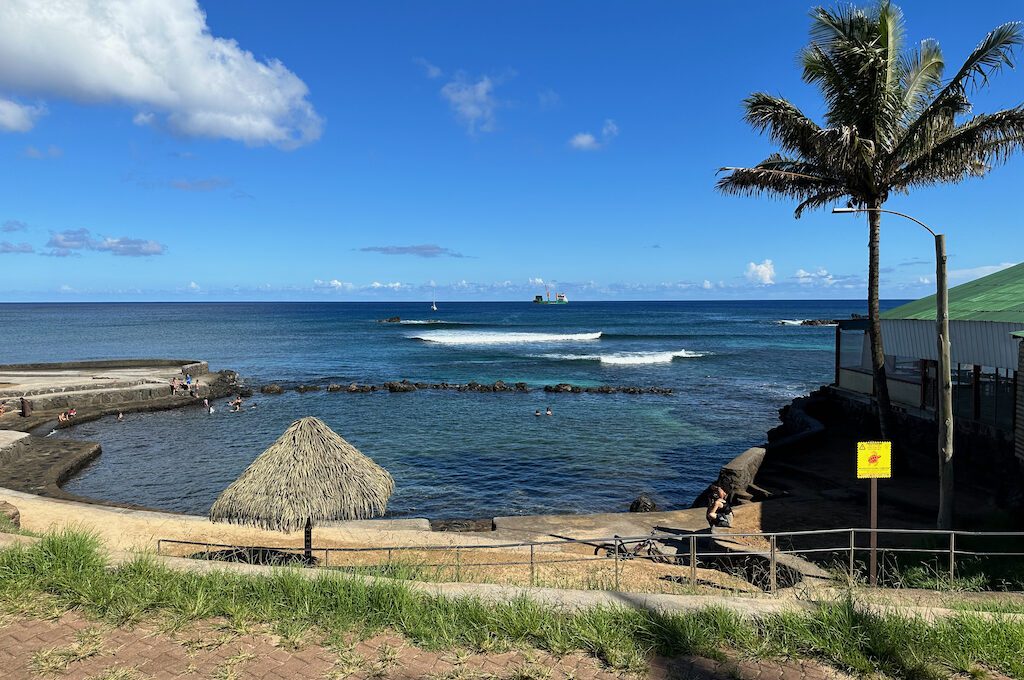
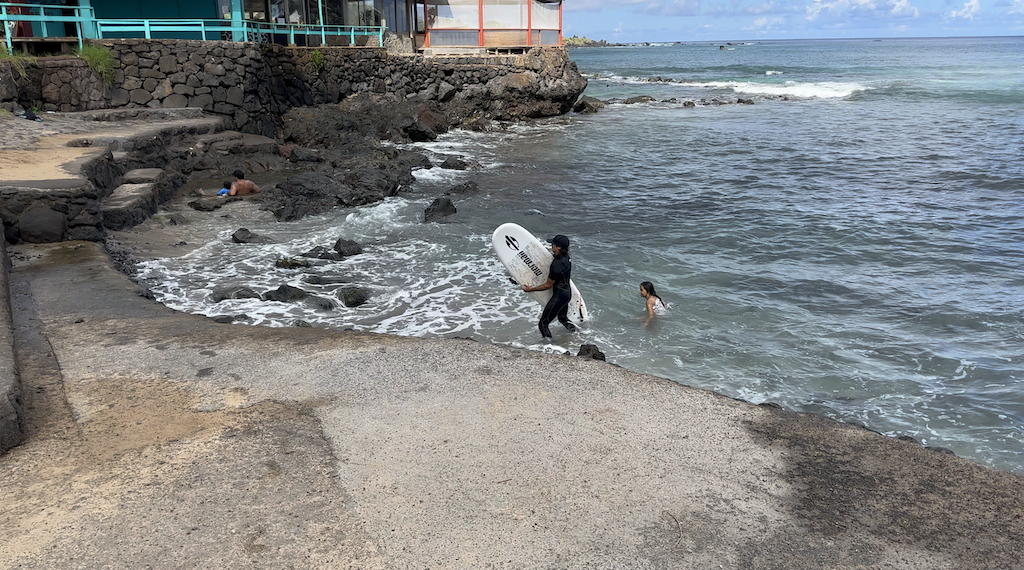
One of the main reasons you come to this swimming area is for an encounter with beautiful sea turtles and we saw several!
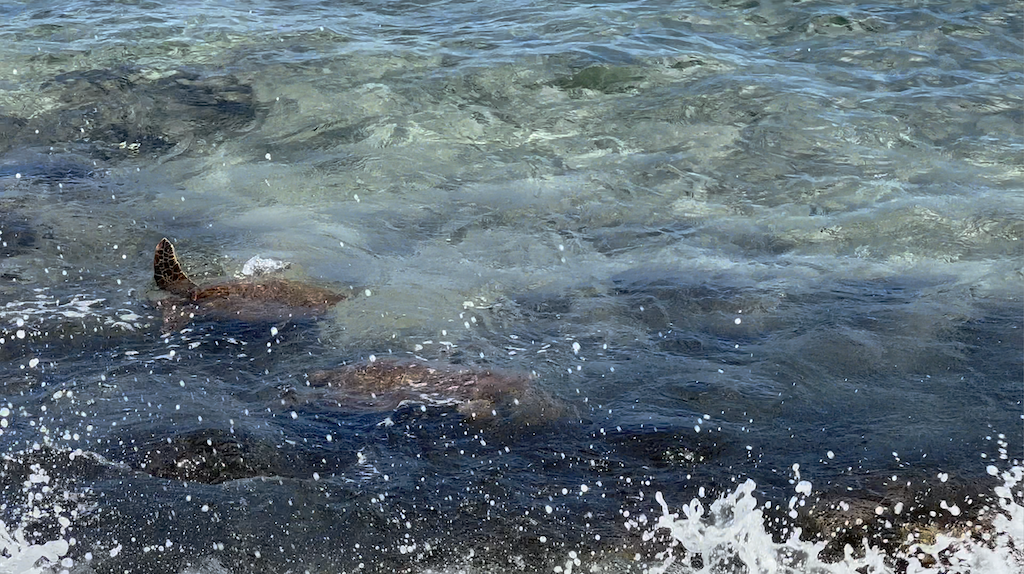
Petroglifos Papa Vaka
There are various places where you can find petroglyphs on Easter island but one popular place to find them is Papa Vaka — the largest petroglyph that has been found on Easter Island.
You’ll see recognizable shapes like fish hooks, a squid, shark and a large tuna etched into the rock. But the biggest design you’ll discover is a huge double cano.
Papa Vaka is located right off the road so it’s extremely easy to access. Consider planning a stop when you visit the beaches on the north side of the island since it is right on the way.
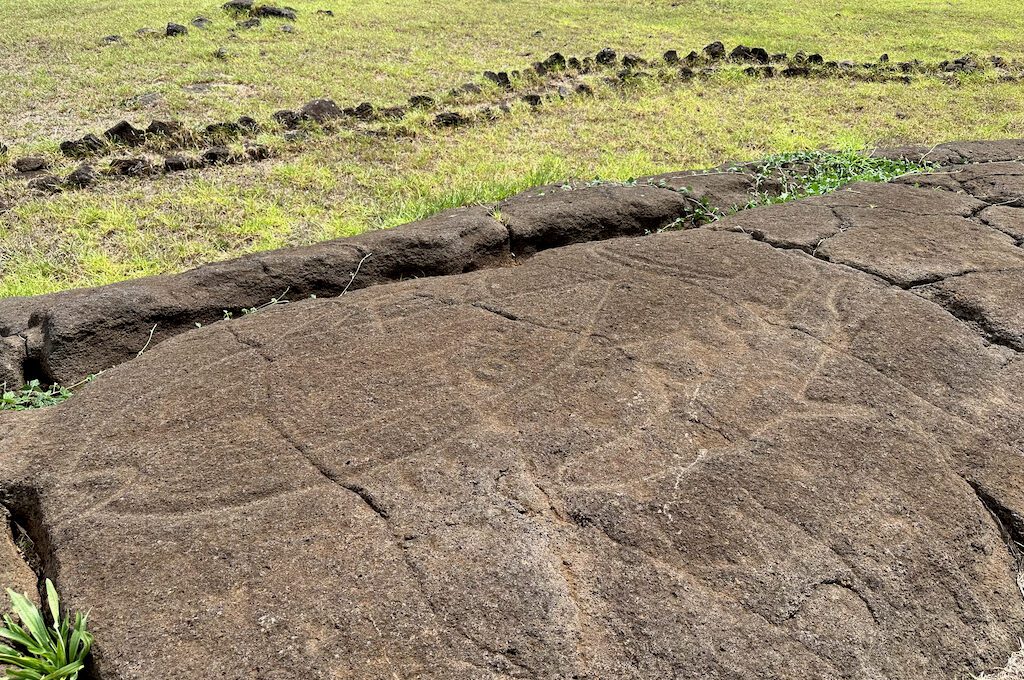
Pu o Hiro
Pu o Hiro is another one of the quick stops along the road — it’s found just across the road from the beautiful man-made bath mentioned above.
At first glance, this just looks like a strangely shaped rock. However, it’s said that this stone was actually used as a musical instrument.
Supposedly, you can blow through one of the holes and it will produce a loud sound similar to a trumpet that was used to summon the god of rain. Apparently making the sound is not easy and there are only a few locals who know how to do it.
If you look very closely you may be able to see some petroglyphs on the rock. Just keep in mind that you have to remain behind the barrier so you can’t come into contact with the rock or give it a blow.
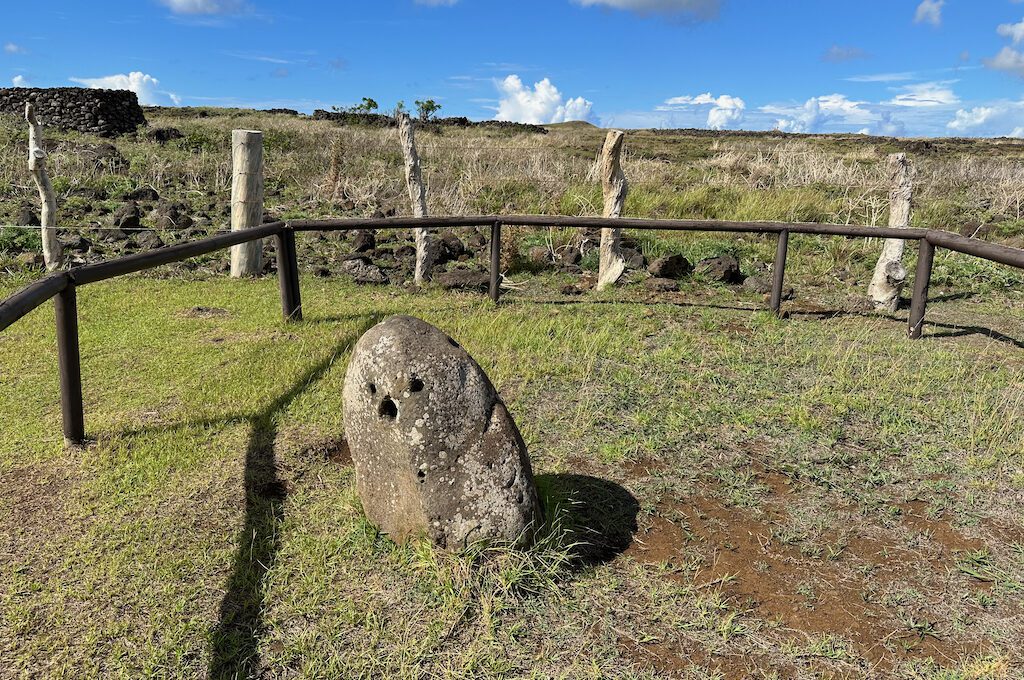
Ahu Akivi
Ahu Akivi has the special designation of being the one ahu that faces out to the ocean (and one of the few that exist inland). It’s believed the construction of Ahu Akivi initially began towards the end of the 15th century, with the moai being added about 150 years before Europeans arrived in 1722.
According to the local legend, King Hotu Matu’a initially sent scouts across the sea to locate Easter Island and to settle there. Seven of these scouts stayed on the island waiting for the king and the seven stone moai here represent those brave scouts.
This is hotly debated based on the late dates of construction though.
Still, this ahu is also significant for being the first to be restored which created the momentum needed to make widespread restorations throughout the island.
The modern day standing moai found on Easter island all started with this ahu!
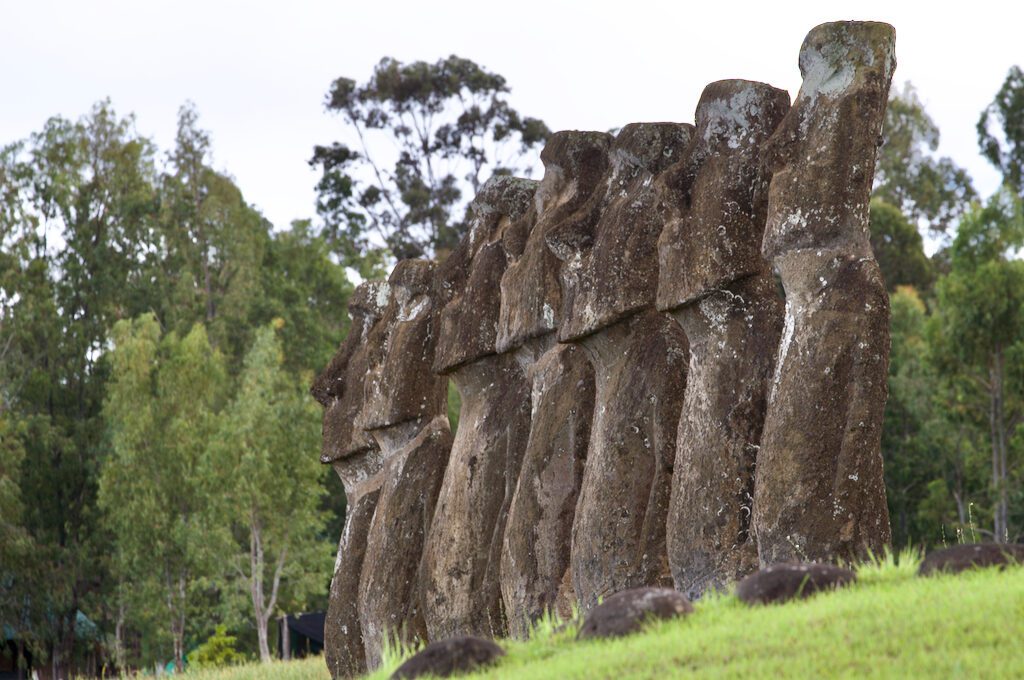
This site also has celestial significance. The moai, which are all of roughly equal size, face sunset during the Spring Equinox but have their backs to the sunrise during the Autumn Equinox.
It’s just a short walk to get to the moai from the entrance, so you can visit Ahu Akivi with relative quickness.
Note: if you want to visit during the special time of the sunrise during the spring equinox, you’ll probably have to get special permission since the kiosks do not open that early.
Something to think about is that the trailhead to the top of Mount Terevaka, the highest point on Easter island, is also found at this site.
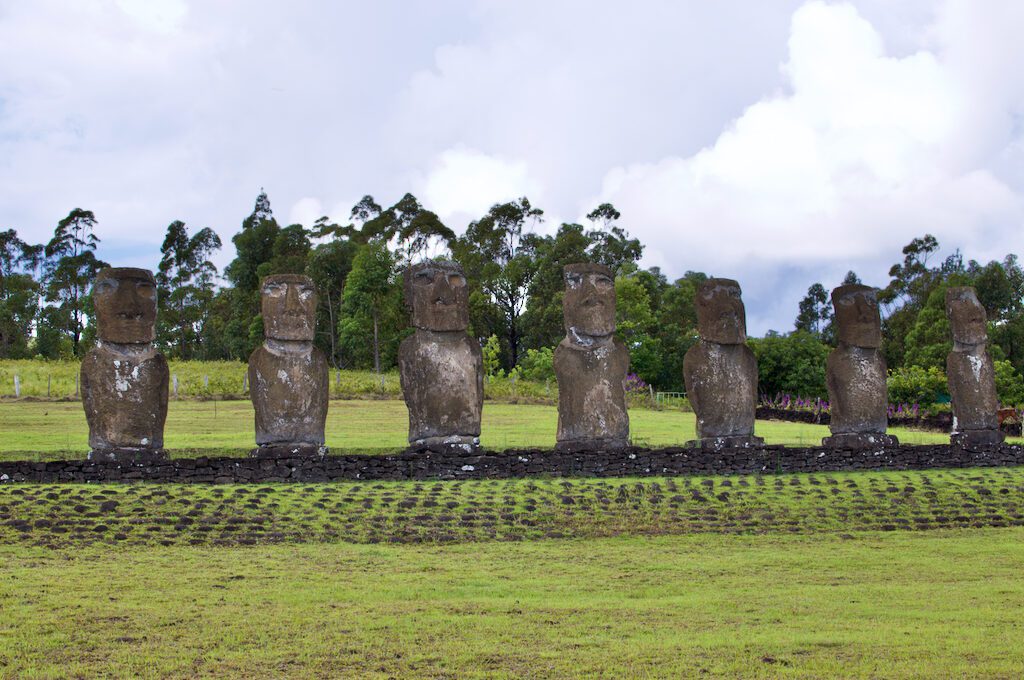
Rapa Nui Museum
Another absolute must visit is the Rapa Nui Museum.
We were extremely fortunate because the museum had just opened up a couple of days before we visited. It’s a pretty compact museum but it is full of fascinating information about the history of Rapa Nui.
A couple of the exhibits that you cannot miss include the coral eyes of a moai which I understand to be the only original coral eyes found. You can see exactly how they fit into the moai up close!
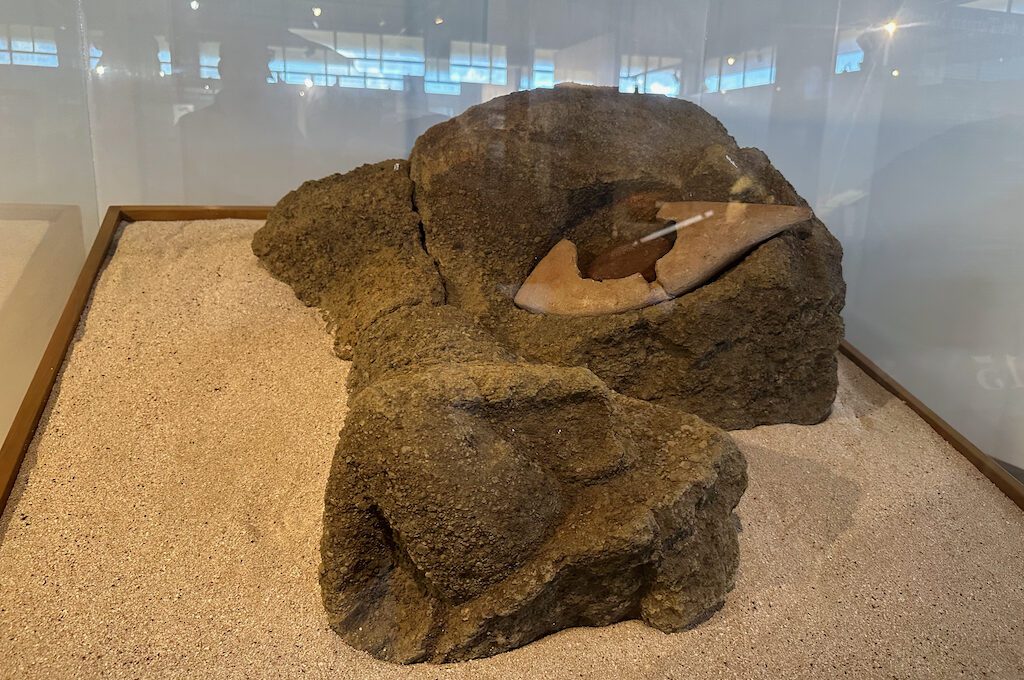
And then there are the scripts of Rongo Rongo, the ancient language that has yet to be decoded. There’s a lot of debate on whether or not this was actually a written language but it’s still really cool to see an ancient, undeciphered script. It looks like something straight out of a movie.
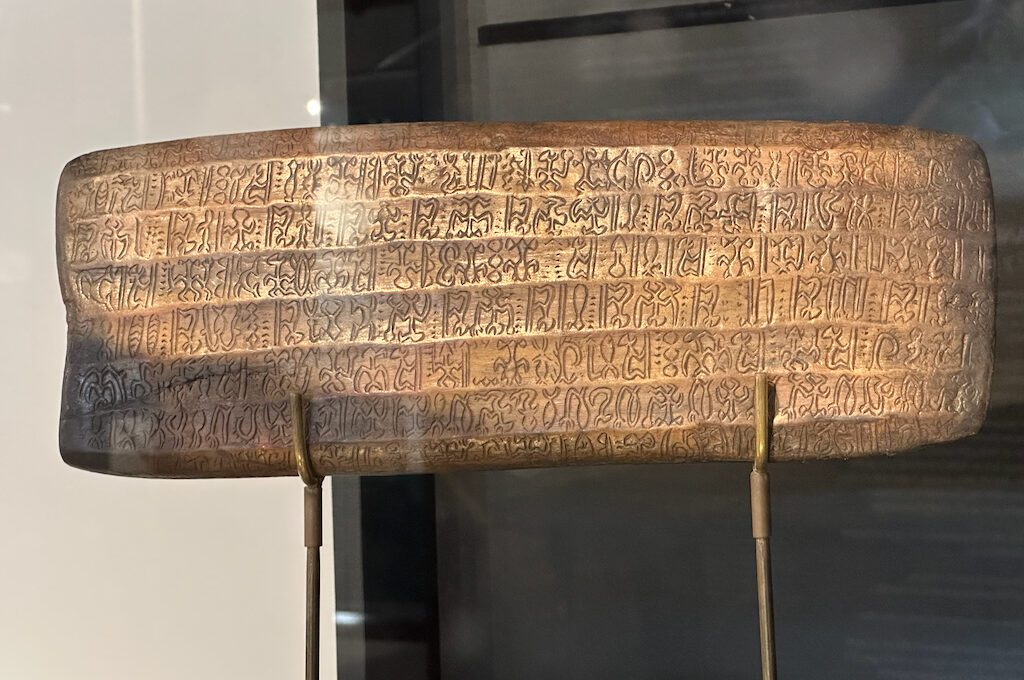
Best of all, this museum is free to visit, so make sure you make time for this because it’s absolutely worth it. (They also have English interpretations for the exhibit panels.) The days of operation and hours can be a little bit weird for this museum so be sure to do some research ahead of time.
Ana Kai Tangata
Ana Kai Tangata is a cave area with historic pictographs that have been preserved inside of the walls of a large cave.
The name “Ana Kai Tangata” is subject to a number of different interpretations including “cave where men are eaten.” Lots of artifacts have been found in the cave including stone tools, pottery, and even human bones.
Some suggest that this site is evidence of the ancient practice of cannibalism but the evidence is still very much debated from what I can tell.
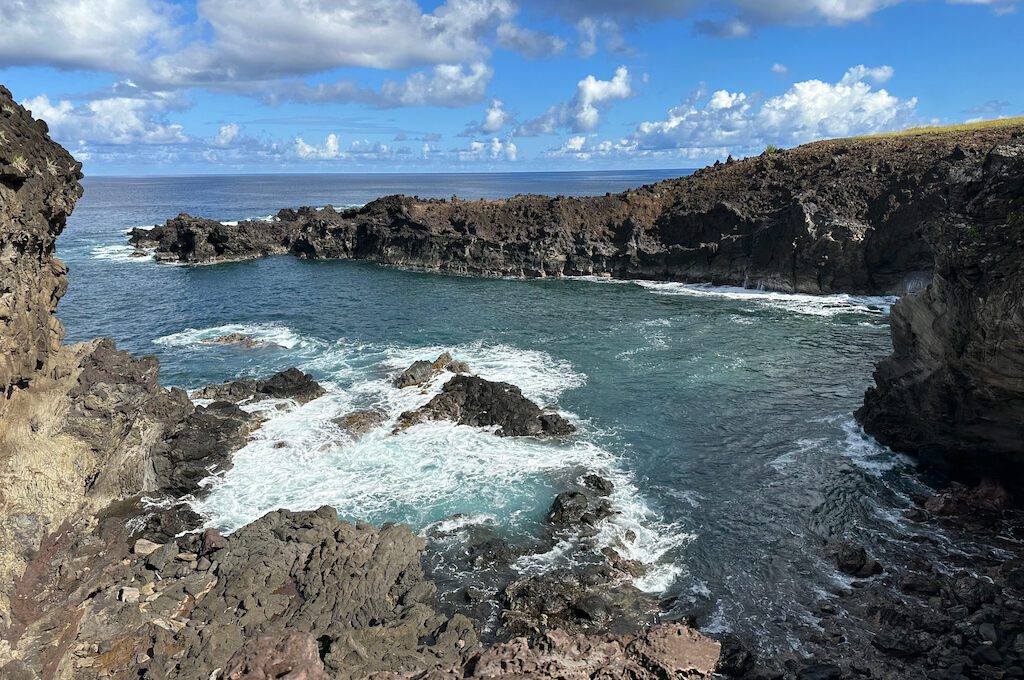
You can still see the historic pictographs on the inside of the cave’s walls but it seems that a lot of the art has fallen off the walls so you may not have much longer to check out these visuals.
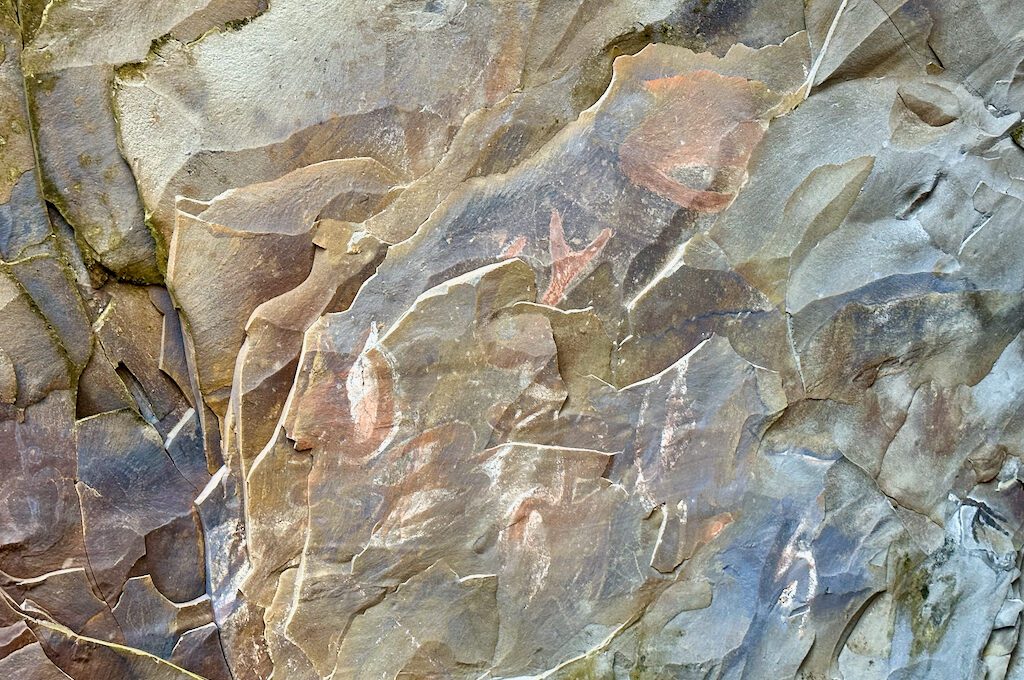
You can venture inside the cave but you have to do so at your own risk. Not because of cannibals but because it’s pretty obvious while you are in there that rock slabs constantly fall from the ceiling so be careful if you choose to go in.
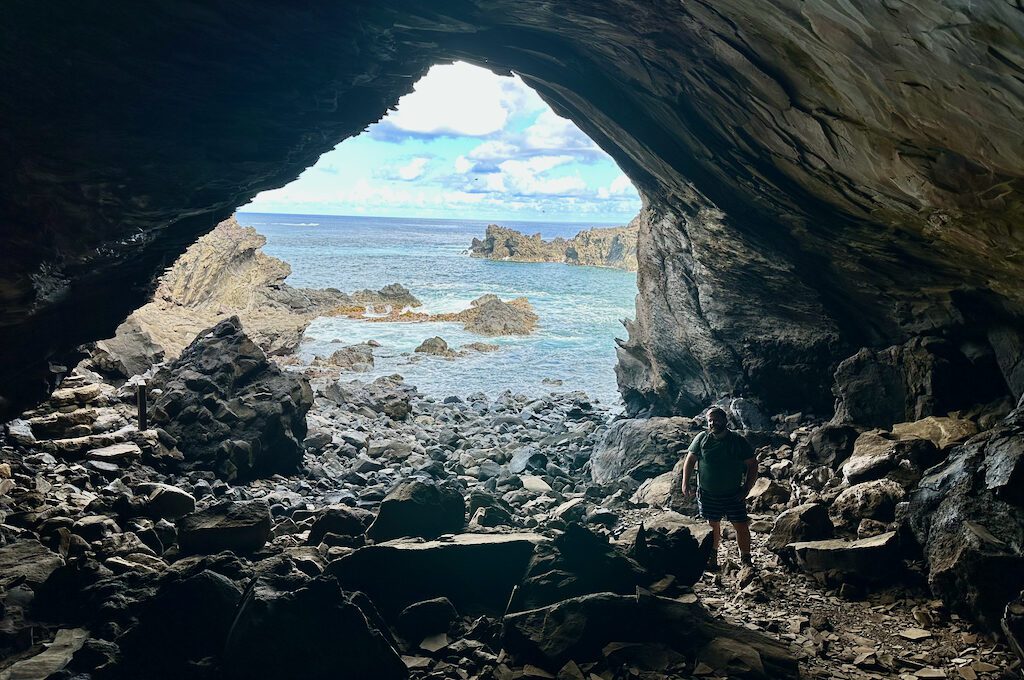
Hanga Roa Beach
Just beyond Ana Kai Tangata, is Hanga Roa Beach. Although that’s the name you’ll find on Google Maps, it’s not much of a beach. Instead, it’s more of a dramatic cliffside with stunning lava rocks.
I’d recommend making some time to just wandering around these cliffs and check out the magnificent views.
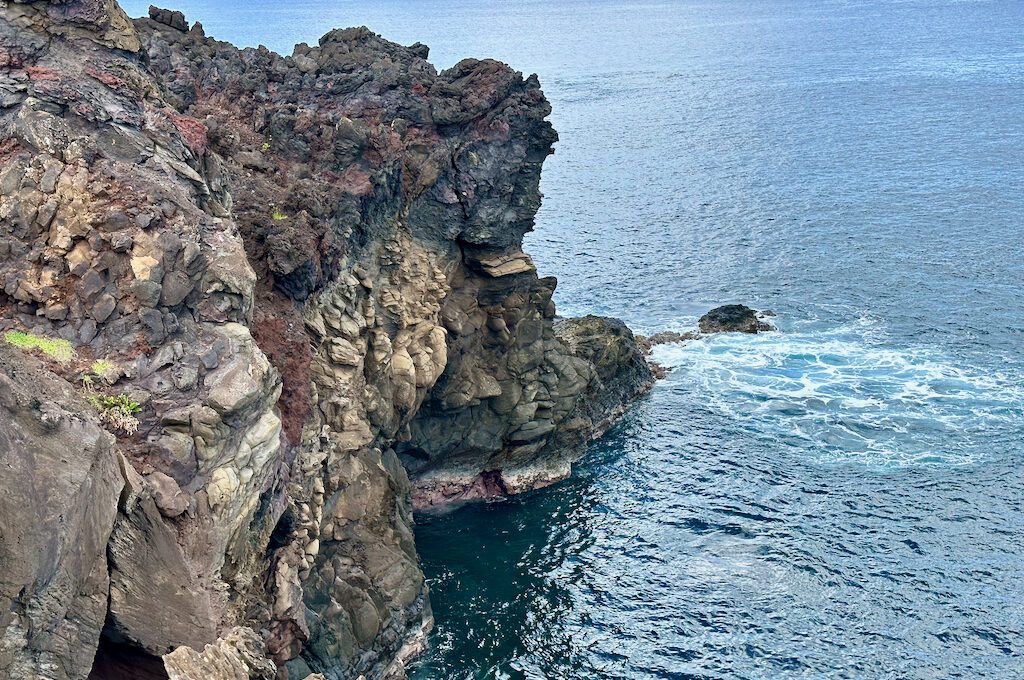
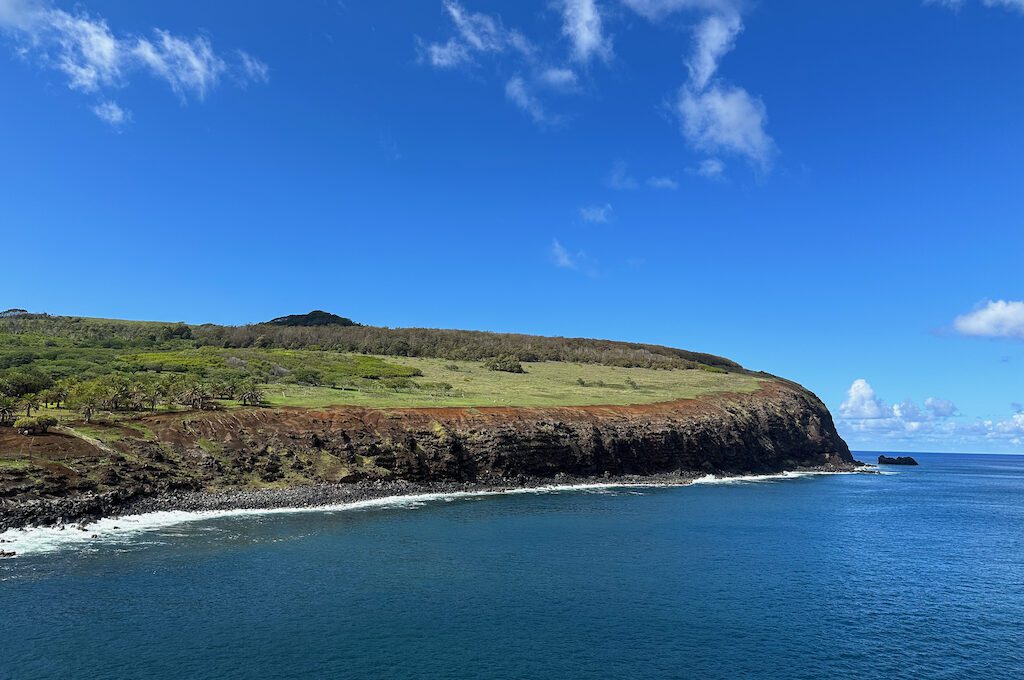
Scuba diving
I was super fortunate to get one dive in at Easter Island considering that I arrived with a pretty bad cold (and diving with a cold is not recommended).
Luckily, it cleared up for me towards the end of the trip but the drawback was that I wasn’t able to go on the famous moai dive.
The reason is that some of the dive shops will require you to go on a refresher dive if you have not recently been diving. My last dive was about 12 months prior in Hawaii so that was not “fresh” enough to avoid the refresher course.
I believe the underwater moai is somewhere around 60 to 70 feet deep and your dive shop may want you to show that you are comfortable before letting you go down that deep.
I was bummed but I could live without it because the moai down there is not an actual moai created by the original inhabitants of the island hundreds of years ago. It’s a recent creation that was used on a movie and TV show so I didn’t quite feel like I was missing out on a piece of history.
With my moai dreams dashed, I felt like it would still be worth it to dive just to see what the terrain was like down there, especially because I had heard so many amazing things about the visibility.
I found the visibility to be great although it wasn’t exactly pinch-me-I-must-be-dreaming clear down there and I would compare it to some of my prior dives.
From what I heard, the conditions were pretty great so I wouldn’t say I was disappointed but just not quite blown away like I thought I might be. We also did not encounter a ton of wildlife down there as the fish, while beautiful, were still not very abundant.
Also, something you should know about the refresher course.
Unlike some other places that allow you to refresh your skills in a pool or shallow water and then go on a dive, Mike Rapu gets you to perform the refresher skills during your dive. Had I known that, I would have really tried to get a second dive in because that eats up such a large chunk of your dive.
(A slight language barrier made it a little difficult to know exactly how things were going to happen.)
I would say to try to plan things out as best you can before you arrive but the dive shop failed to get back to me when I tried reaching out prior to arriving so it really made things difficult to plan anything out.
In the end, due to the cold I was dealing with, I doubt I was going to get a lot of diving action in on this trip so just getting one dive in was honestly a win for me.
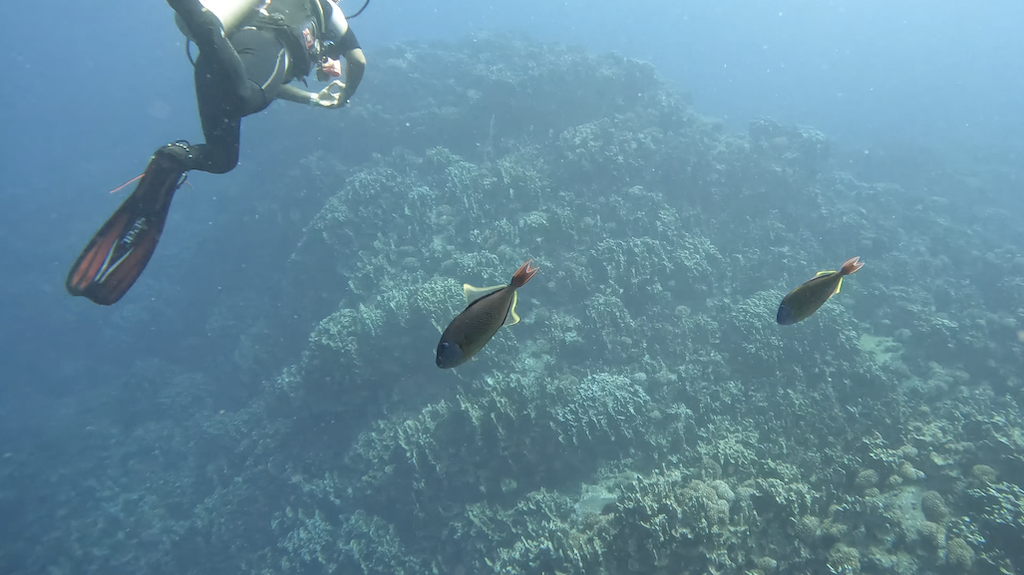
Ahu Vinapu
When it comes to the ahu, Ahu Vinapu is probably the most interesting one on the island.
Located on the south coast of the island near the airport, the main ahu here is called Ahu Tahira and it faces the winter solstice at sunrise.
But the real reason it stands out is the ahu showcases a style of stonework found nowhere else on the island.
It’s a style that many believe is transplanted from the Inca and is evidence of the early contact between the continent of South America and inhabitants of Easter Island.
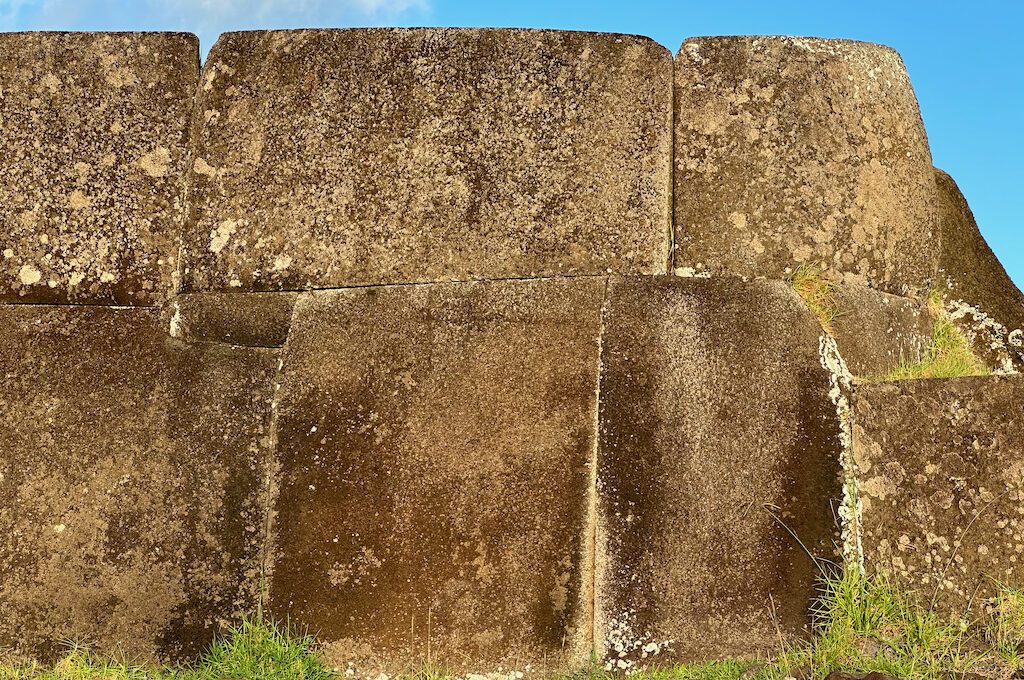
Specifically, the precisely cut basalt slabs resemble the techniques found at Saysachuaman and at the chullpas of Sillustani (near Lake Titicaca).
Some historians speculate that Inca Tupac Yupanqui may have arrived at Easter Island during an expedition to the Pacific around 1480, though there’s still a lot of mystery around these claims.
Another point of interest is the red column that stands alone, which represents a rare feminine moai. According to some, this may have possessed two heads.
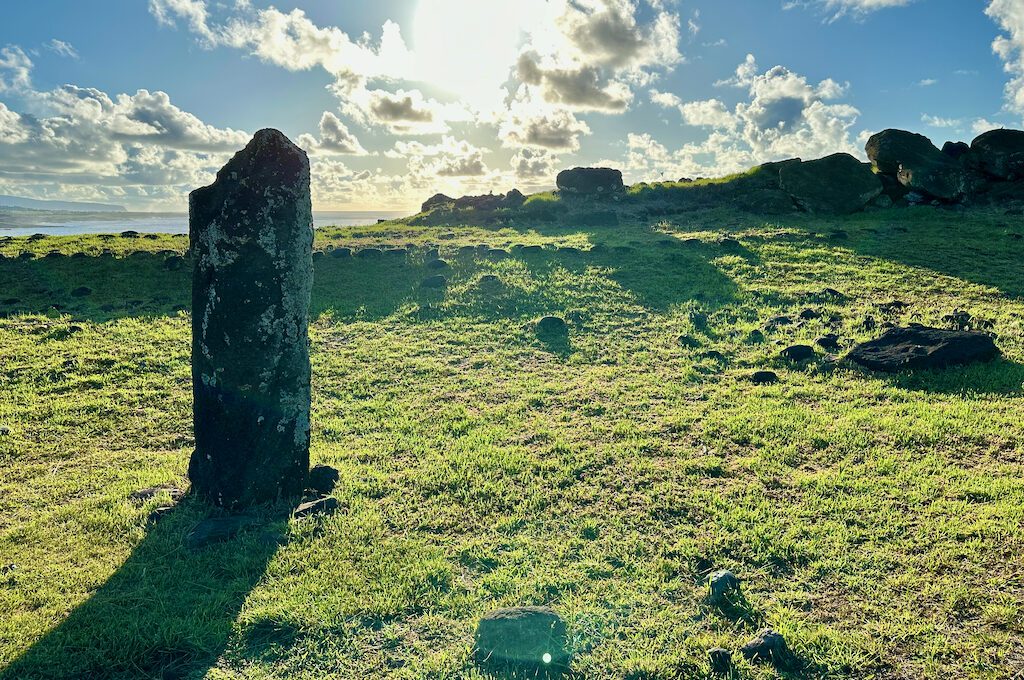
The secret beach (27°10’09.5″S 109°23’52.9″W)
Nearby Ahu Vinapu, there’s a beautiful stretch of coastline worth checking out. At the very least, you can just pull over and check out the view for a few minutes. Find it near 27°10’09.5″S 109°23’52.9″W.
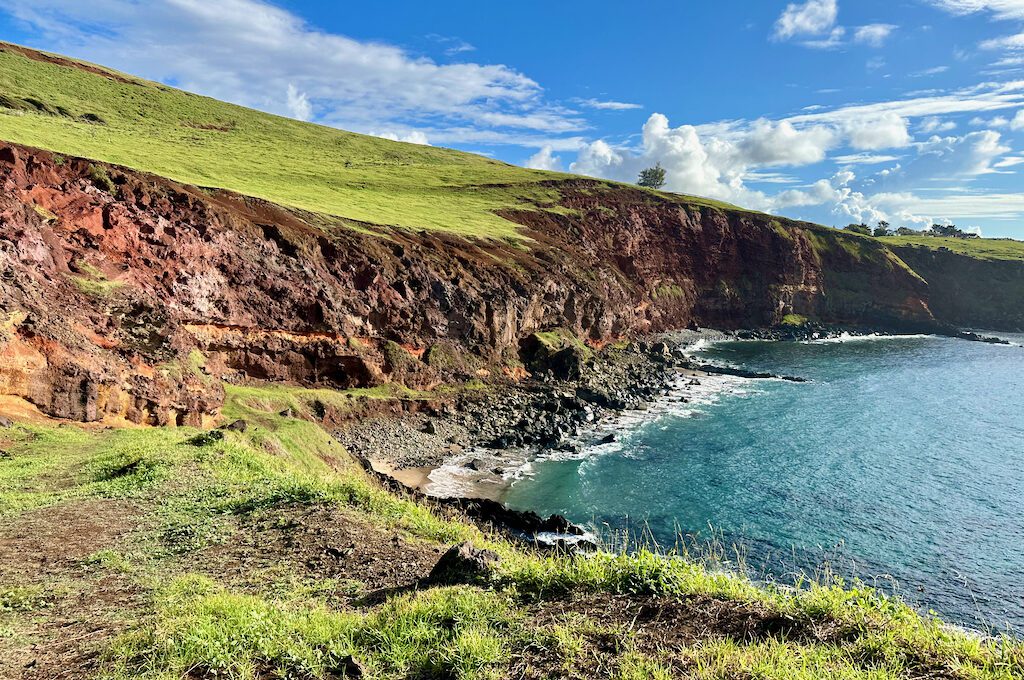
You can descend a few hundred feet and check out the little beach cove if you have the time and energy. It’s sort of like having your own private beach which is pretty cool but you may want to be careful during high tide. I’m not sure how powerful the waves get.
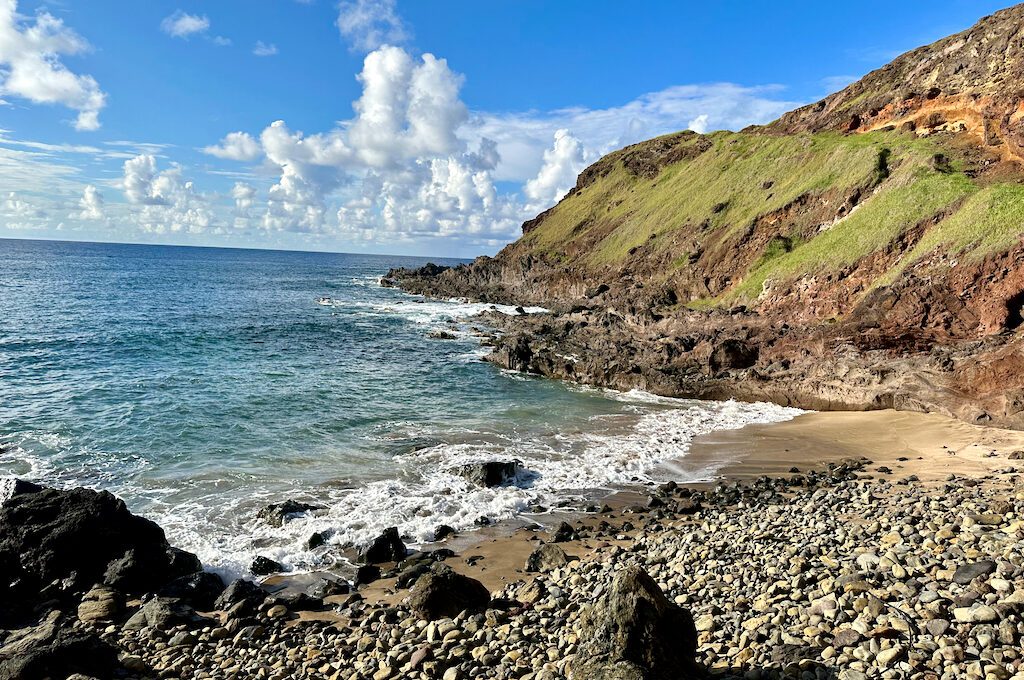
Puna Pau
Puna Pau is the red scoria quarry found on a small extinct volcano. It includes a reddish color due to the iron oxide it contains and was used to carve the hats or (hair) that went on top of the moai, known as pukao.
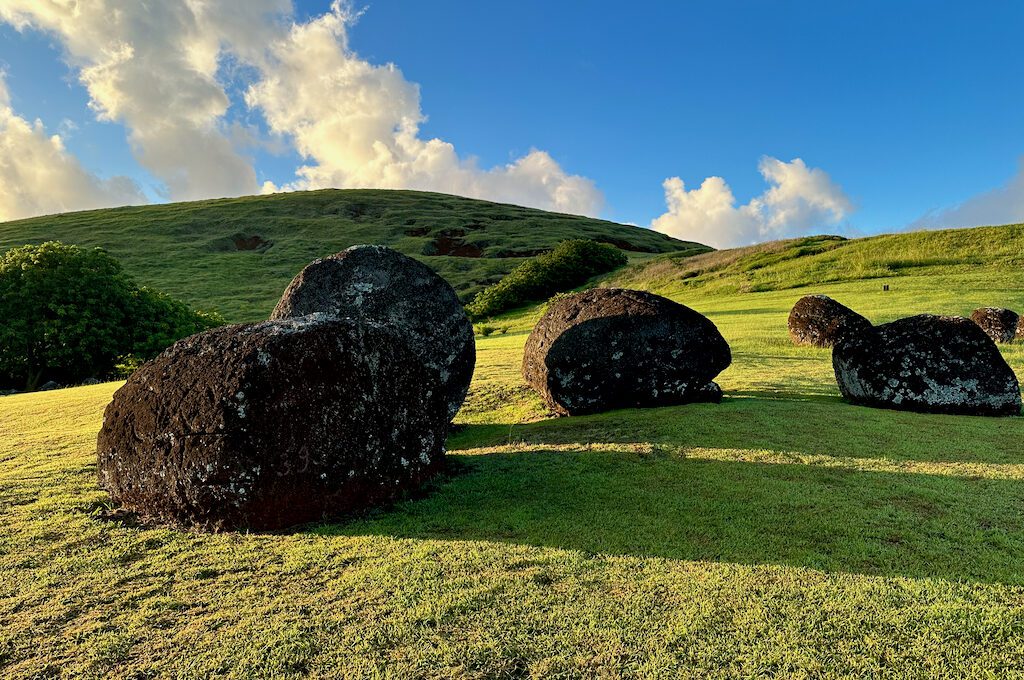
This is a pretty small site so you don’t need to plan a lot of time but just be ready for a short but relatively steep walk. It’s beautiful to take in during the morning.
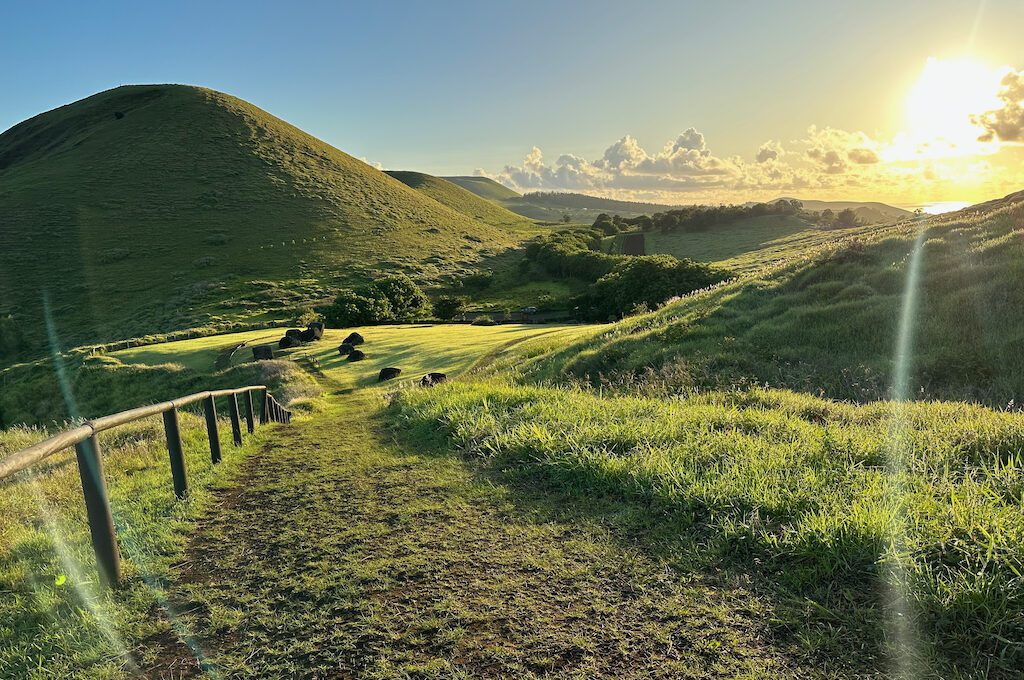
I was surprised to find that some of them had designs in them along with notches presumably made them fit on the heads better.
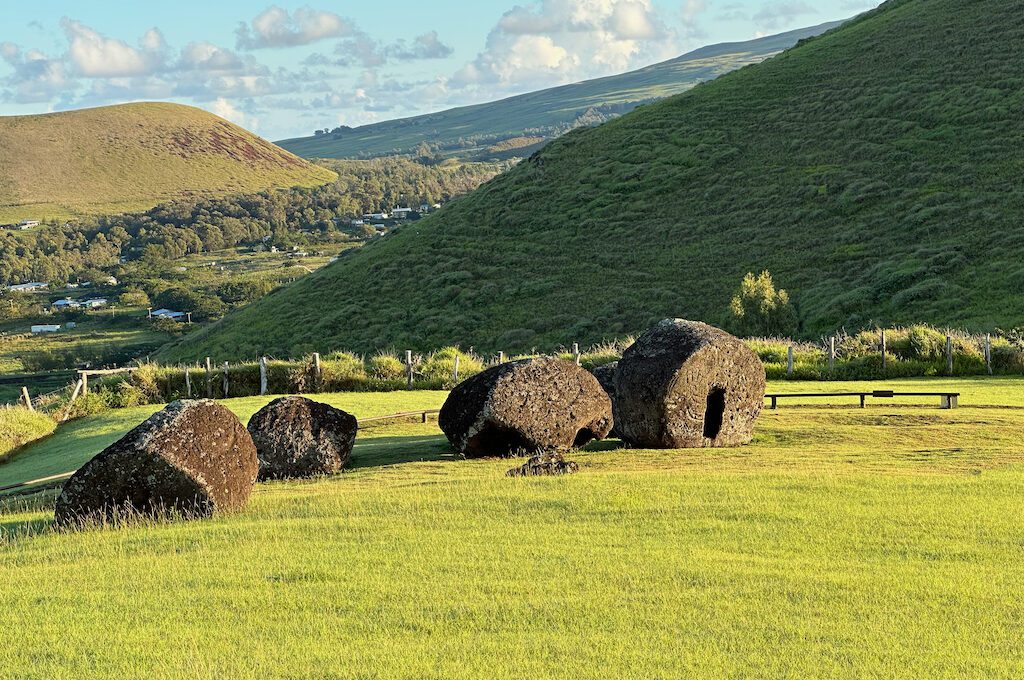
Ahu Huri A Urenga
Ahu Huri A Urenga is another spot that you can visit without a guide and it’s generally going to be a very quick visit, as it’s located right off the road.
This is yet another ahu found inland and consists of one lone moai standing tall on a platform 13 meters long by 4 meters wide.
The moai here is particularly interesting because it has two pairs of hands and nobody really knows why.
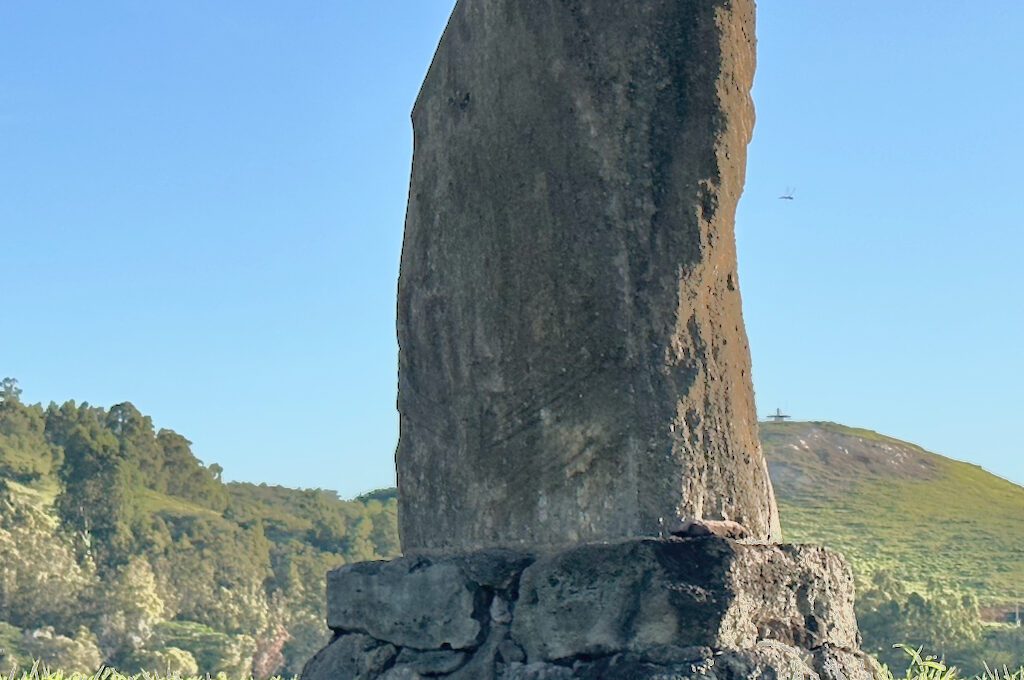
Likely used for funeral rituals, this ahu and moai also has celestial importance.
Both the statue and platform line up with where the sun rises during the winter solstice. Also, at the entrance, you can find a water well and stone holes that were used to accumulate rainwater and these reportedly aligned with the stars during certain times. Pretty fascinating stuff.
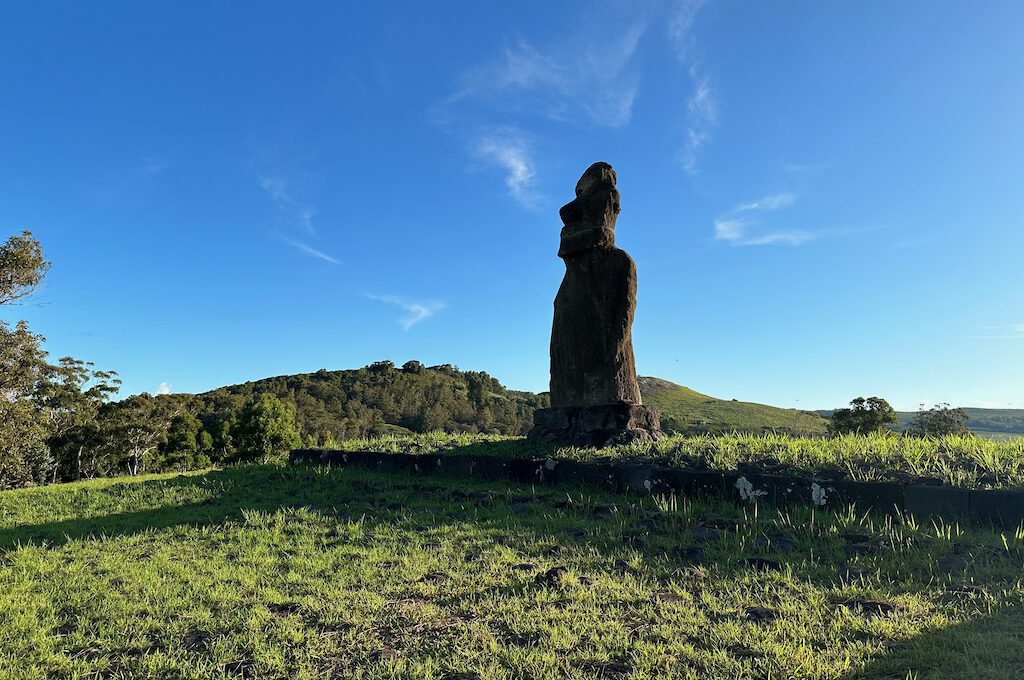
Ahu Akahanga
Ahu Akahanga is home to the remains of an ancient village where it is believed that the first king was buried.
You’ll find lots of ruins here including the old foundations of houses and stone ovens.
The main ahu here, spanning 18 meters in length, has several toppled moai. Interestingly, the face both down and up which is in contrast to most of the moai that were toppled face down.
Where exactly the body of the original king could be is anybody’s guess, as modern excavations haven’t been able to confirm if those remains were actually buried here.
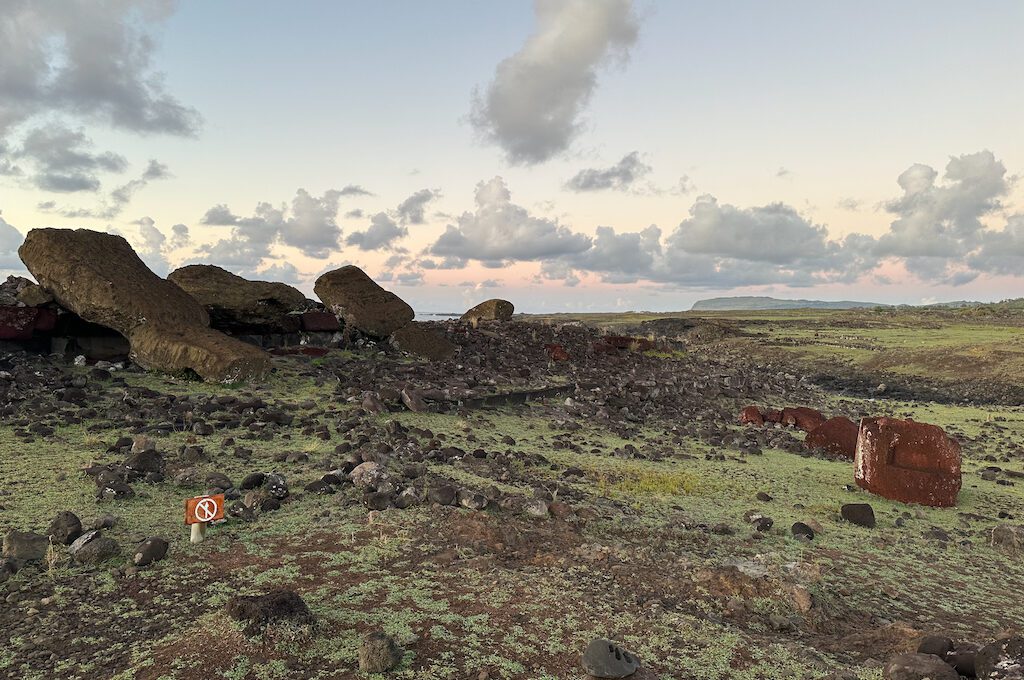
One moai that lies on its back behind the ahu is thought to be one of the oldest carved moai. The older moai did not have as much detail and were shorter than the larger ones that later came out in a more uniform condition.
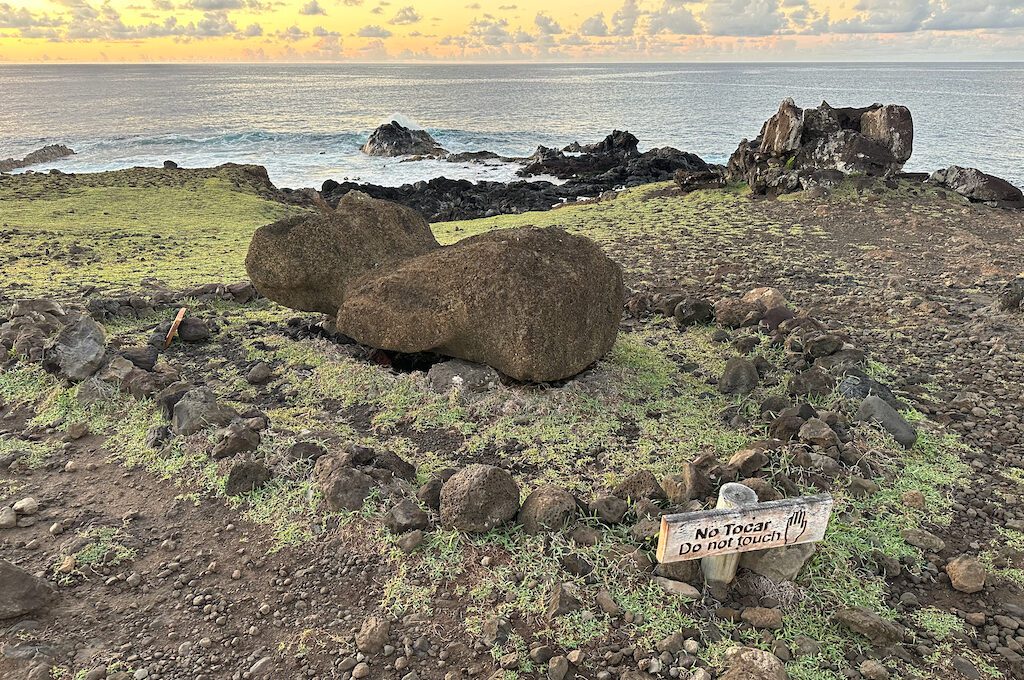
Another site worth checking out before leaving is the small cave which would have provided shelter to fisherman working along the coast.
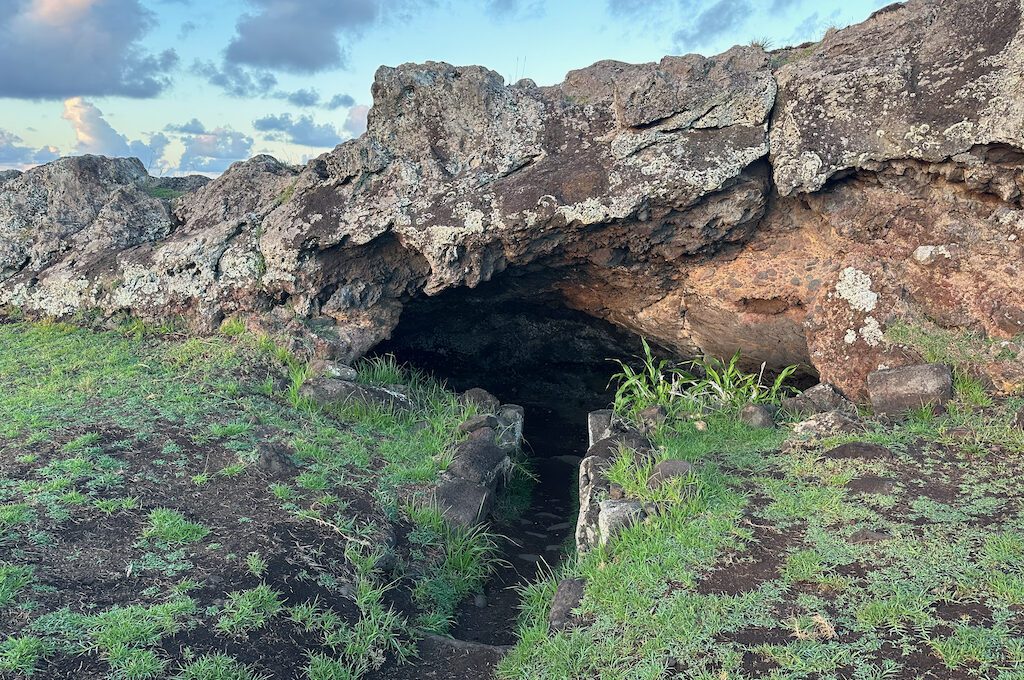
Te Pito Kura
Te Pito Kura is one of the most visited moai spots, as it is home to two pretty remarkable things.
First, you’ll find Paro Moai, which represents the largest moai ever successfully raised at an ahu. The moai is astonishingly 10 meters in height with its ears alone measuring 2 m. They estimate that this thing must weigh 80 tons or more.
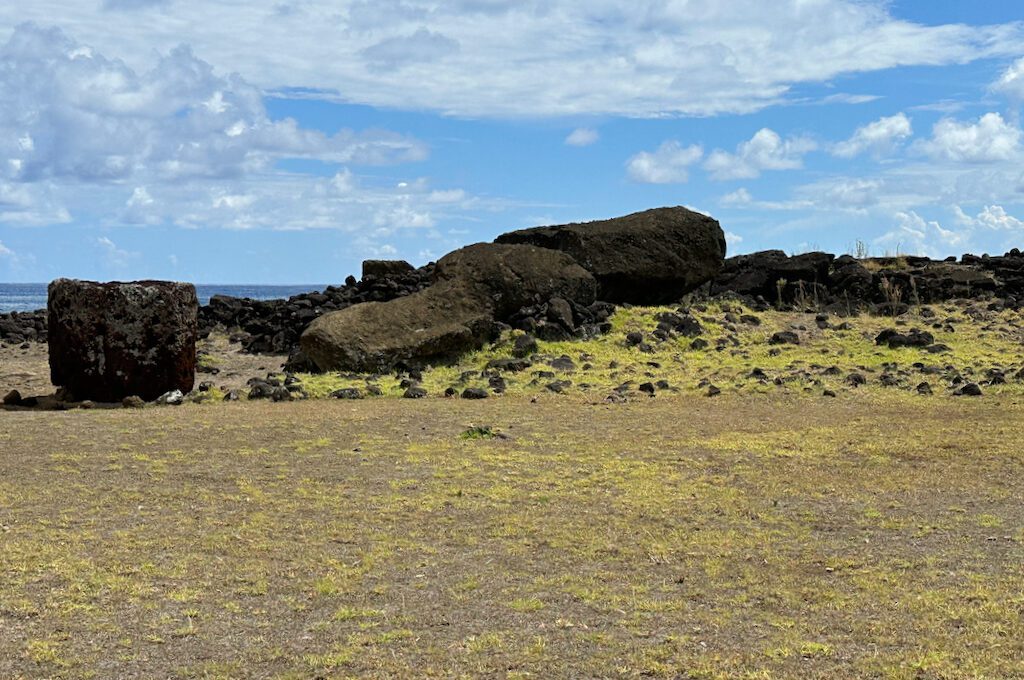
Just beyond that oversized moai is a large ovoid shaped stone called the “navel of light” and some people call it the “navel of the world.” It’s a special stone because according to legend it was brought over by Hotu Matu’a, the founding king of the Rapanui people because of its special energy, or mana.
The stone has a high percentage of iron content which is activated by heat and will throw off a compass if it’s put too close.
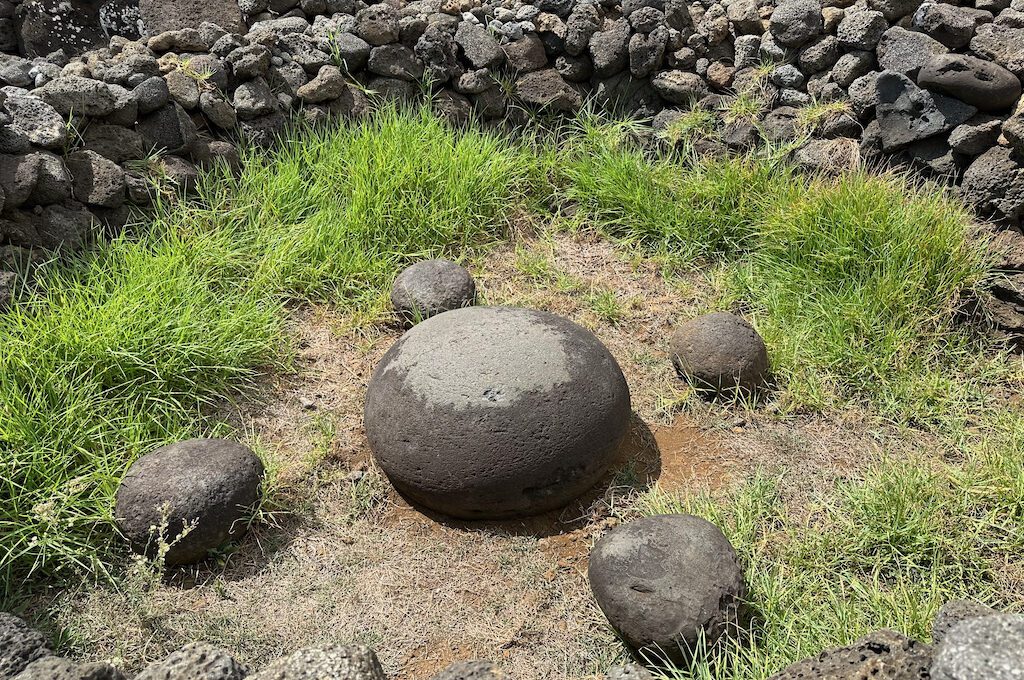
Hanga Te’e / Vaihu
Hanga Te’e/Vaihu is the very first place that we visited and could be the first spot your tour guide decides to take you to.
It’s home to a large ahu, 86 meters long and 12 meters wide, which made up the base for eight statues. The statues now lie on their face and give a good indication of what the sites looked like during the 18th century.
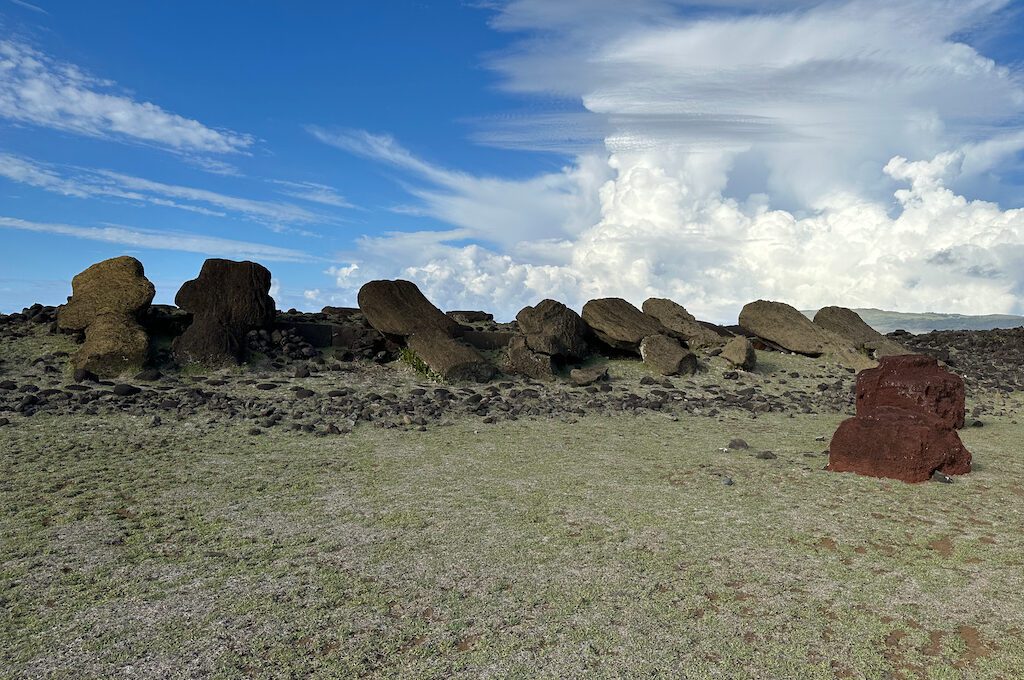
Something else cool about this spot are the models found at the Centro de Interpretacion that depict what the homes looked like along with other things like chicken coops, ovens, and orchards.
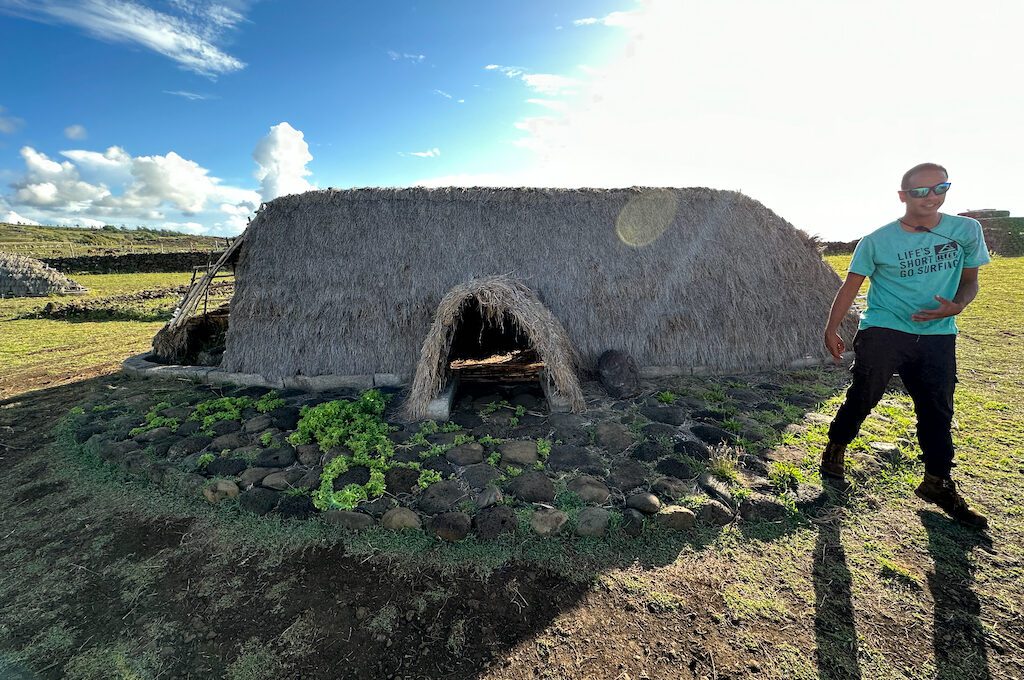
Other sites
As you explore the island you’ll find countless number of ahus and moais located all around the coast line.
Some of the sites that are less prominently featured on maps are okay to visit without a guide so you can explore these places when (and if) you decide to ditch the guide.
I’ll list some of the places below that I would try to check out but you are bound to stumble upon at least a couple of places.
Try to take some time to investigate these because sometimes you may only see a pile of unremarkable blocks from a distance but upon close examination you may discover a beautifully preserved moai.
Just make sure you are aware of what’s off-limits because at some of these lesser visited sites, it’s kind of difficult to know where are you permitted and where you’re not.
Ahu One Makihi
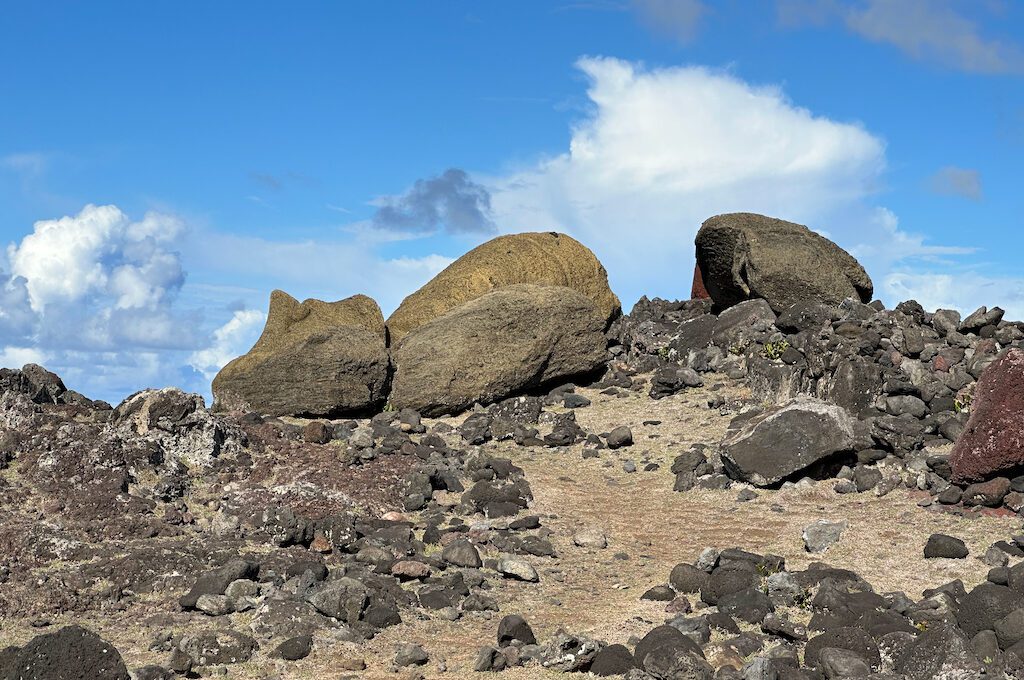
Ahu Riata
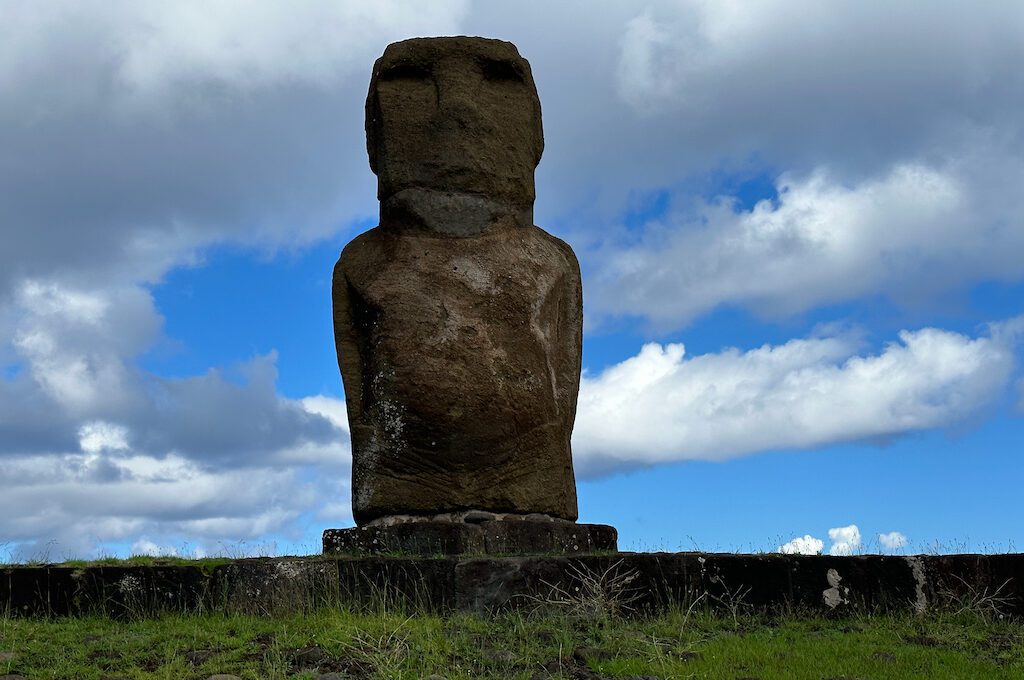
Random fallen moai (27°08’13.4″S 109°18’38.7″W)
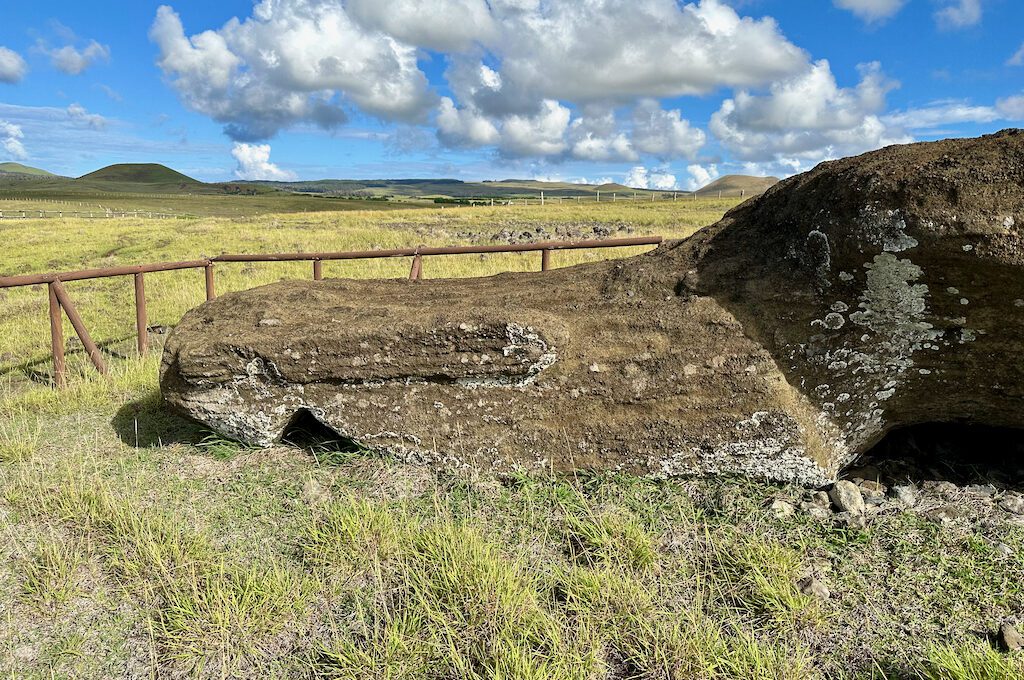
Sunday morning mass
One thing that some travelers like to do is attend Sunday morning mass at the local church.
That really did not appeal to me but I had a dive scheduled for Sunday morning anyway which was the last available spot for me so this was not really an option. Still, for something different it might be worth checking out.
Horseback riding
You’ll find horses everywhere on Easter Island.
And if you enjoy riding horses or if you want to give it a try, this is probably one of the best places. Specifically, you can look into tours that will take you to places that you can’t access with a vehicle due to a lack of roads. So you can really explore more of the island and get away from crowds.
I kind of regret not looking into horseback riding more but our schedule was so full during the week we were there that I don’t think we would’ve had time anyway!
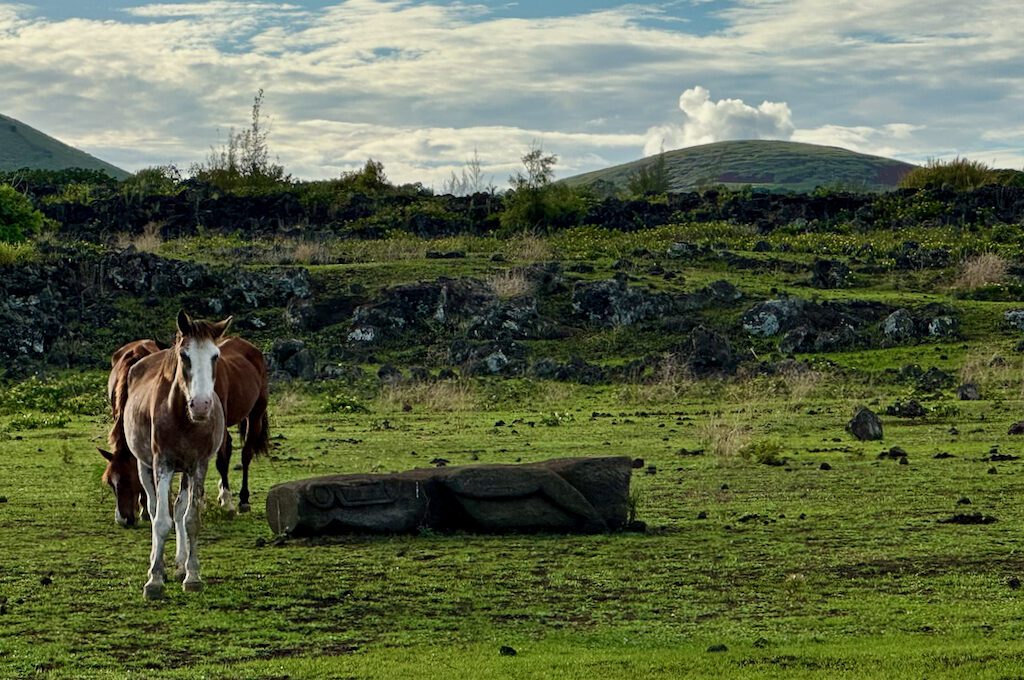
Visit the Sernatur
Back when we originally had a trip to Easter Island planned in 2016, I was stoked about getting my passport stamped. Unfortunately, we had to cancel the trip but the tradition still lives on today just in a different form.
You can head to the visitor information center, also known as the Sernatur, which is where you can ask for a passport stamp. It’s 100% free and you don’t even need to tip.
Just keep in mind that this is considered a “souvenir stamp” and there is always the small risk that it could cause problems down the line in some countries.
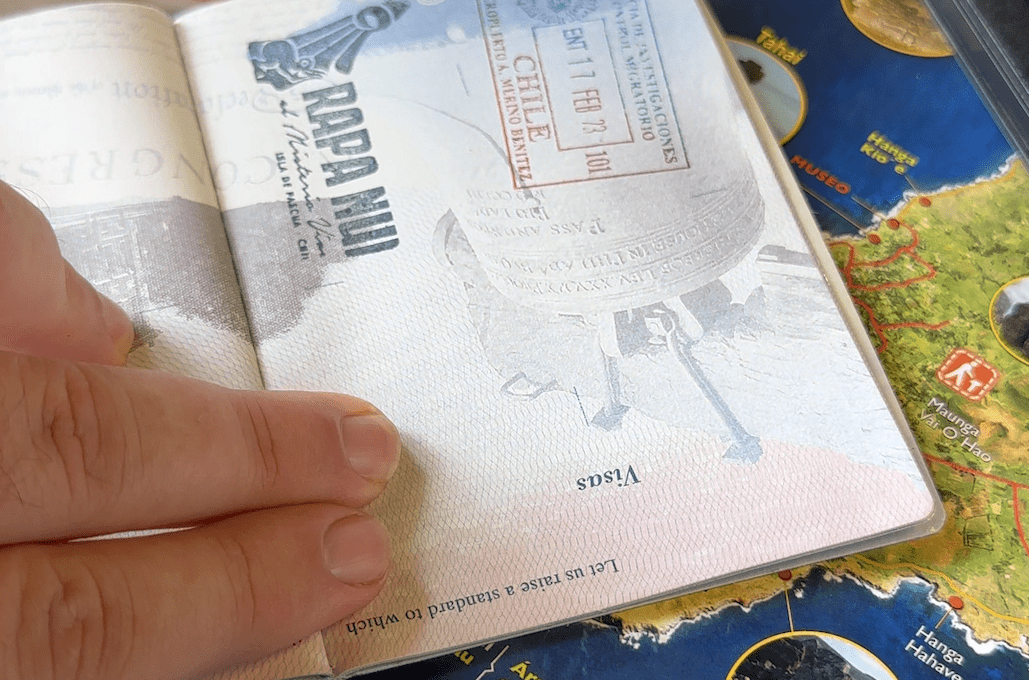
This is also a great place to get a quality map because some of the maps that the rental car agencies hand out are not super helpful. They had two people in the office who spoke great English and were able to explain a lot of things. So if you have questions that is absolutely the best place to go.
Additional reading: To get more context around a lot of the sites mentioned in this article, check out this website that goes into great detail for a lot of the sites.
Final word
There’s obviously a ton of things to see and do on Easter island. Hopefully, this article has helped you to round up some ideas for things to do and given you some insight on what to expect!
Daniel Gillaspia is the Founder of UponArriving.com and the credit card app, WalletFlo. He is a former attorney turned travel expert covering destinations along with TSA, airline, and hotel policies. Since 2014, his content has been featured in publications such as National Geographic, Smithsonian Magazine, and CNBC. Read my bio.

